Where can I get Forrester?
Forrester is available on http://zzt.org/?p=database&search=doom.zip" target="_blank">DigitalMZX along with versions of http://vault.digitalmzx.net/">MegaZeux for major OSes at the top of the front page.

Forrester
Released: Jun. 09, 2009

This time we're going to play some MegaZeux. MegaZeux being ZZT's one successful clone and a quite impressive one! Its development is still continuing to this day. It has ports for Windows, OSX, Linux like you'd expect, but is also available (albeit not necessarily in its latest version) on the Nintendo Wii, Nintendo 3DS, and Sony PSP via homebrew.
MegaZeux, as mentioned in the previous Closer Look at ZIG, had its issues in its MS-DOS exclusive days which limited its audience to a more technical one, but these days it's easier to begin using than ZZT. It's not a subject I'm as familiar with as I'd like to be. My years of playing hundreds of ZZT games dwarf the small handful of titles for MegaZeux I've bothered with, so I'm far from the best to discuss its own vast array of games from 1994 onward, but Forrester definitely fits the criteria here as we'll see.

Forrester is a MegaZeux game yes, but it's a MegaZeux game that is deliberately styled to look and play like a Super ZZT game! Its title screen is reminiscent of the baked in menu for Super ZZT with Monster Zoo, with its rainbow background and 80 column width without a visible HUD.
At the same time, Forrester takes an unusual change in tone compared to its Super ZZT aesthetics. It feels like a Silent Hill game in a way. There's no supernatural horror, but there are strong themes of memory, forgetting, and what it means to be forgotten. All of these would all be right at home in a Silent Hill release. So, let's dive into this adventure into unforgotten.
Like Super ZZT, the game opens with the player riding across water to create a scrolling introduction to its world. The game takes place in the land of Wayward, where everything is forgotten. The introduction also covers the enemies that the player will fight against, again in parallel to Monster Zoo's intro, and also brings up the game's cast of characters. The cast is elaborated a bit more in an HTML file included with the game, but these characters and their personalities will be covered plenty within the game itself.
The intro ends with a warning that if the player themselves becomes forgotten that they'll never be able to leave Wayward.
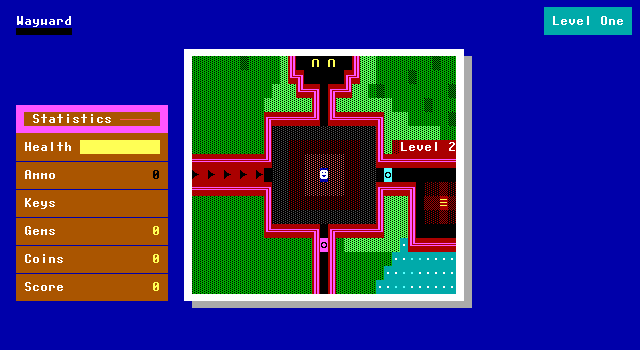
Forrester begins and its Monster Zoo influences instantly become apparent. The central hub, the graphical style, the layout itself, and of course the game's HUD which mimics Super ZZT's quite well. MegaZeux boards can be resized, but default to taking up the entire 80x25 character screen. Here an overlay is used to create the limited visibility window mimicking a viewport you'd see in Super ZZT games instead.
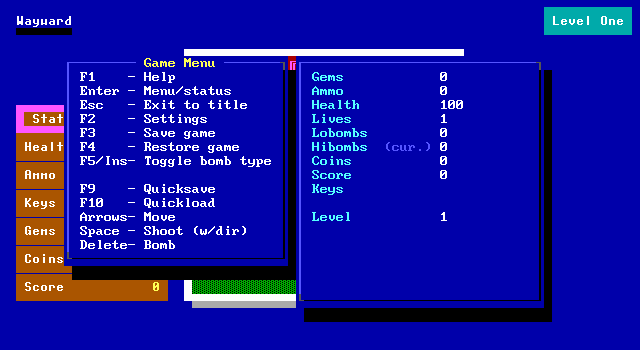
MegaZeux lacks an automatic display of the player's stats, resulting in MZXers having to either code their own as seen previously, or having the player press enter where the player can look at this information. MegaZeux offers more counters than ZZT, as well as custom counters like the "Level" value seen above.
Much like how ZZT incorrectly guessed what kind of games people would make a decade later, remnants of classic MegaZeux show up here. MegaZeux has two types of explosives the player can collect, and then some strange choices of Insert and Delete being used to select each type of bomb and drop one.
Unlike ZZT however, where torches get adapted to magic or healing items out of necessity, MZX supports custom counters making stats like bombs often completely vestigial.
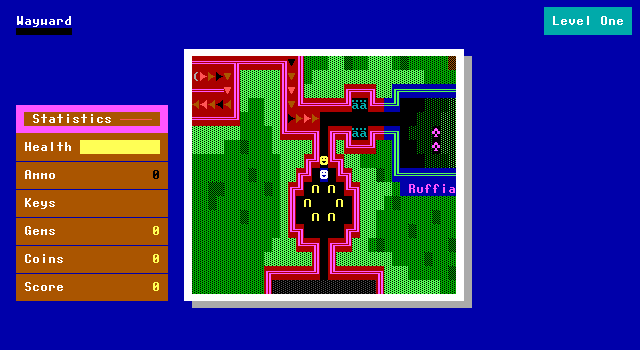
Forrester begins exactly like Monster Zoo before it with this same layout save for the addition of the old man.
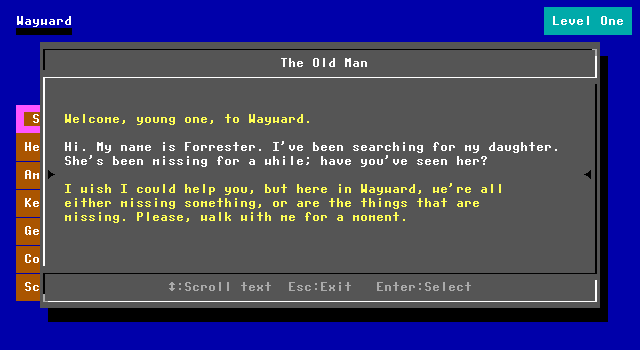
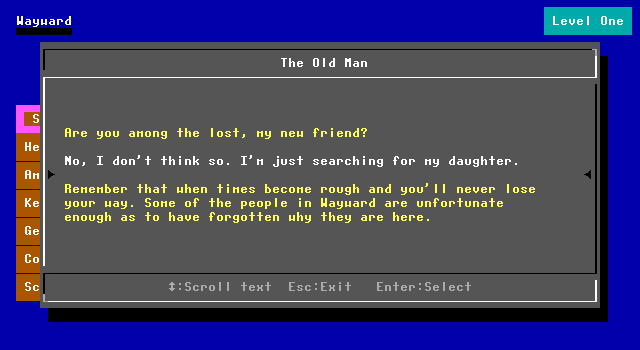
MegaZeux has a similar scroll set up to ZZT, but much wider and using white on dark gray text. It also allows for custom text colors though the scroll itself will always be dark gray. Many more contemporary MZX games go so far as to code their own message systems rather than use the built in capabilities, but Forrester has a style it needs to mimic, and big gray scrolls fit the aesthetic much better.
The old man introduces Forrester to Wayward, and the importance of remembering that he's looking for his daughter. He leads Forrester up towards some ammo before speaking once more about the dangers of Wayward and letting the player go about their quest.
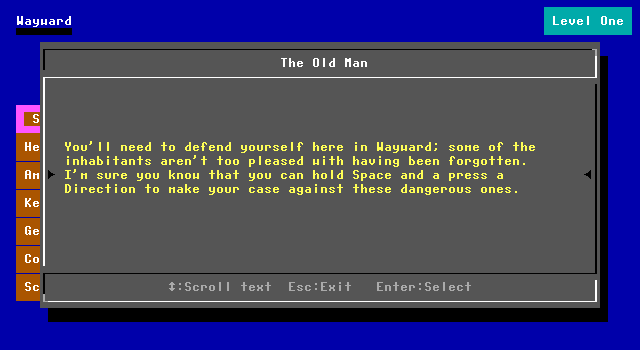
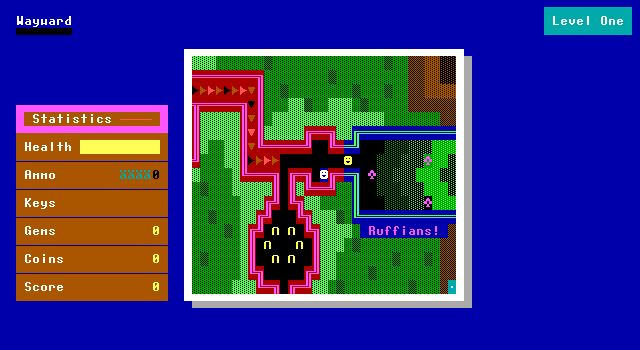
Collecting the ammo gives 5 bullets, matching ZZT's ammo rather than Super ZZT's which bumps it up to 10. The HUD shows the ammo literally, with the digit being a number from 0-4 for the remainder. It's an interesting way of presenting the information, but just like Super ZZT's health bars it makes the specifics hard to tell at a glance.
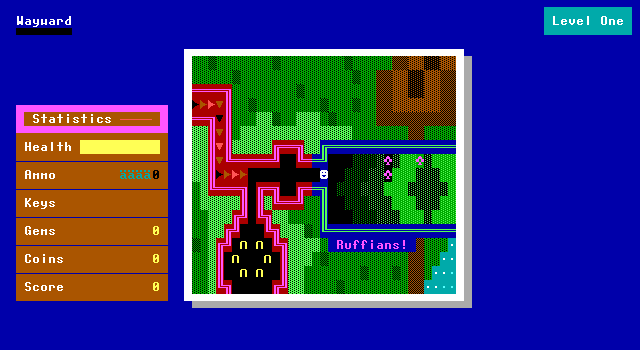
The first enemies Forrester faces are ruffians, which are MegaZeux robots (what MZX calls its objects) that move a few spaces before idling in place. The ruffians all have matching periods of movement and rest, which means everything is moving or standing still simultaneously. It's clearly meant to be a (Super) ZZT ruffian, but feels off enough that somebody with experience in ZZT will immediately see their flaws compared to the real thing.
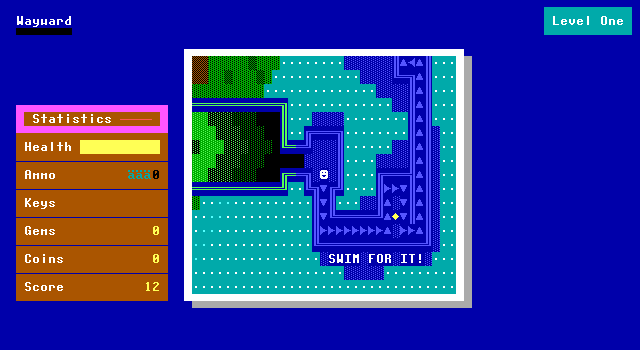
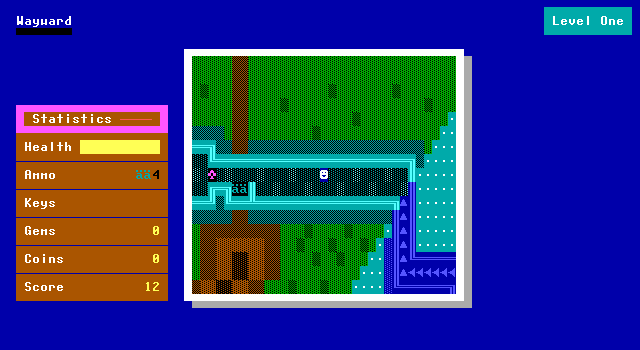
Up ahead is a river which carries the player using the same mechanics as Super ZZT which MegaZeux conveniently also implements. If they're fast enough they can escape the river momentarily for a gem before being carried to the end of the line. There are a few more ruffians ahead, but also another one of the residents of Wayward, the Jester.
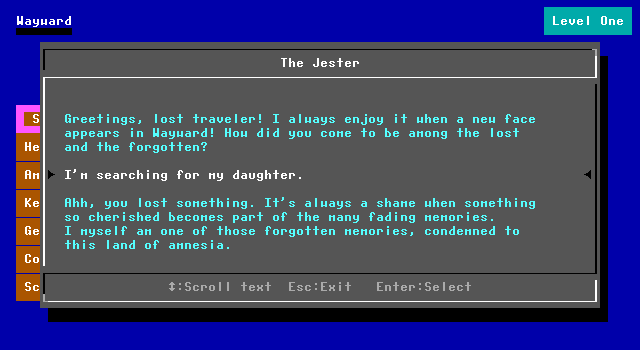
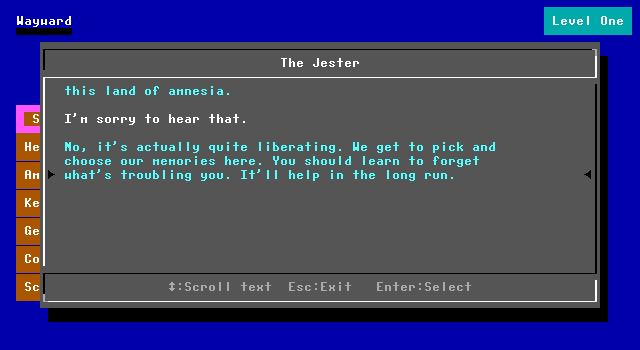
The Jester has embraced being forgotten and espouses its benefits. Forrester however can't comprehend wanting to be forgotten.
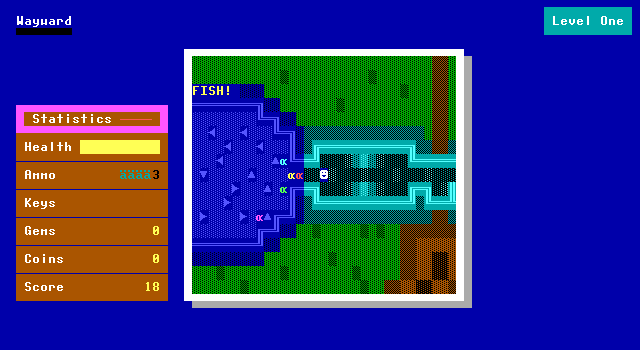
Following the jester is a small aquatic room with fish and some rapids. These enemies are native to MegaZeux and not found elsewhere. ZZT has sharks for an aquatic enemy, but they are invincible and the player can't move into water. Fish move very erratically though they're easy to snipe with the setup here as they can't leave the water.
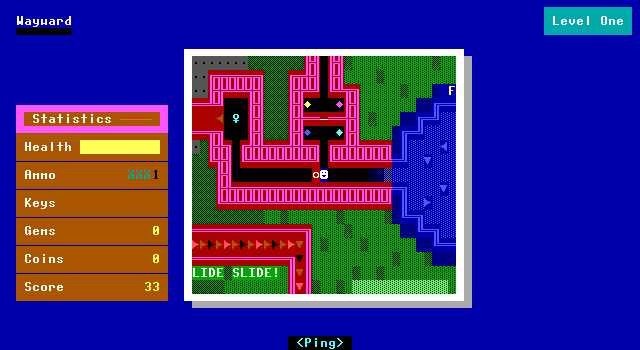
There's a locked door here which resists the stray bullets intended for the fish that wound up hitting it. To proceed Forrester will need to find a way to open it.
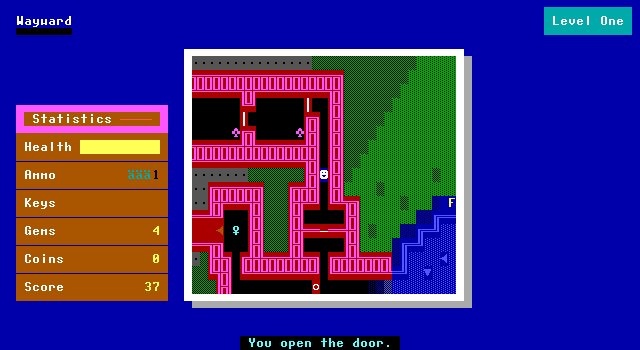
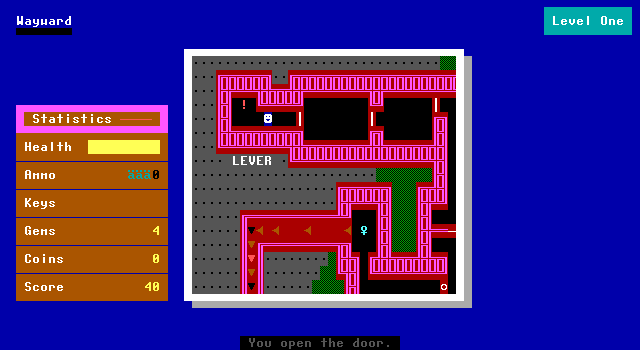
Some small chambers with a single ruffian in each obstruct the player but are easily overcome. The reward is a lever to pull and open the door below.
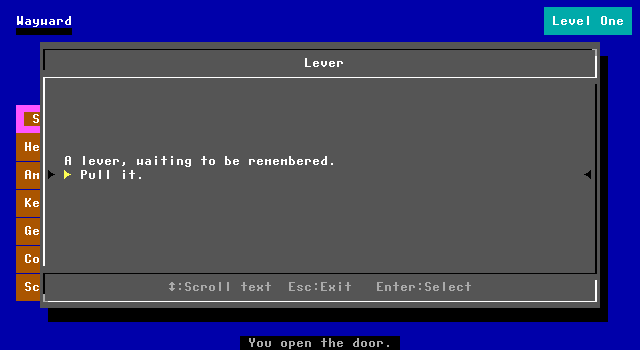
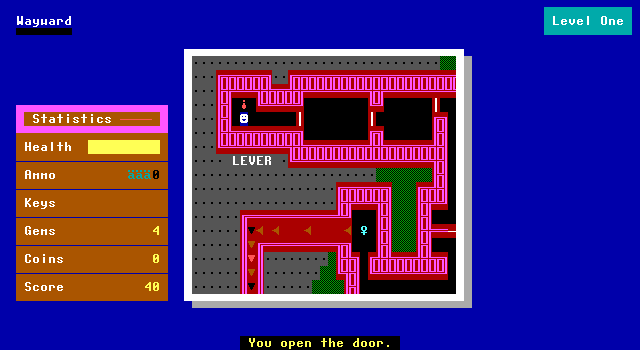

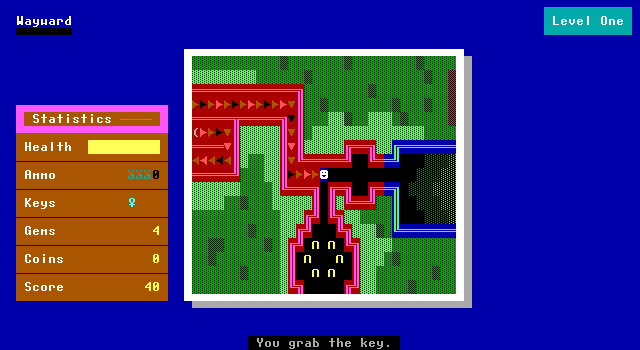
Behind the door is the cyan key to the next level, and a river ride to the start of level one.

Before making it to the entrance to level two, another character shows up to speak with Forrester.
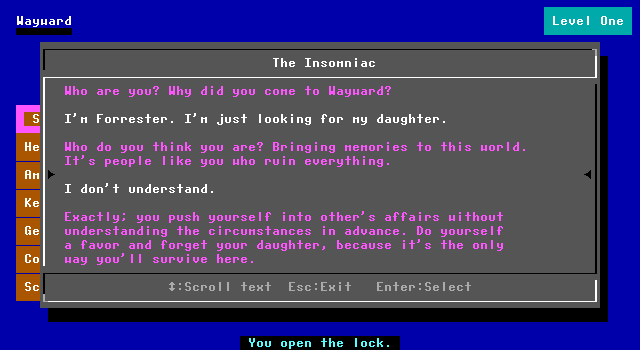
While the old man is friendly to a new face, and the jester wants Forrester to embrace a new life in Wayward, the insomniac is more hostile. He warns Forrester that he'll ruin things, but doesn't impede him, letting the player move on to the second level.
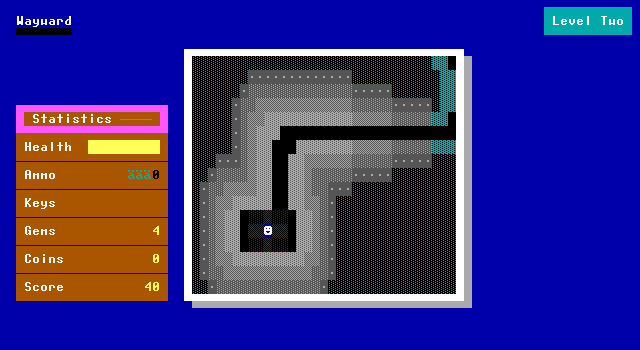
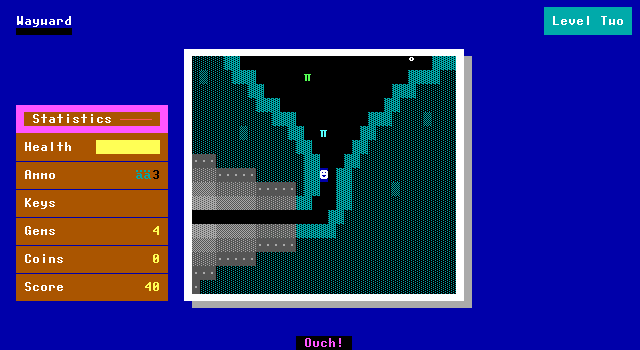

The second level opens up with a room leading to a cavern filled with various colored tigers which also contains a large sign for ammo. Although somewhat reminiscent of the dragon caves of Monster Zoo, the direct influences become much more muddled as the game strives to have its own voice and not just repeat what came before it.
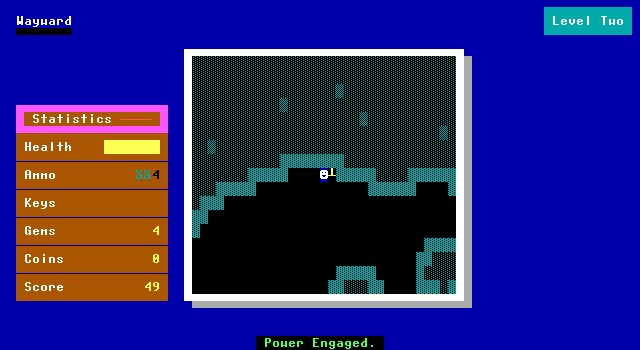
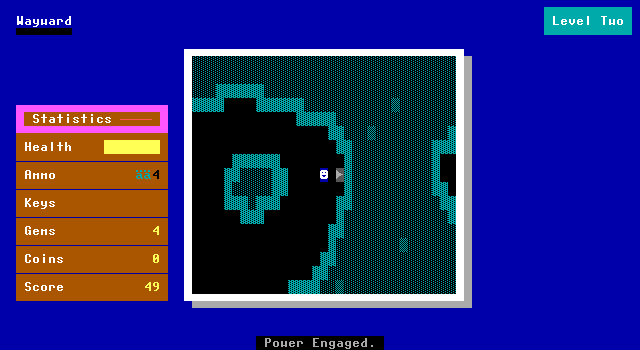
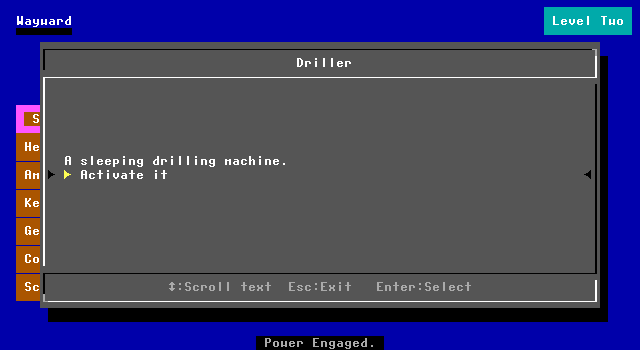
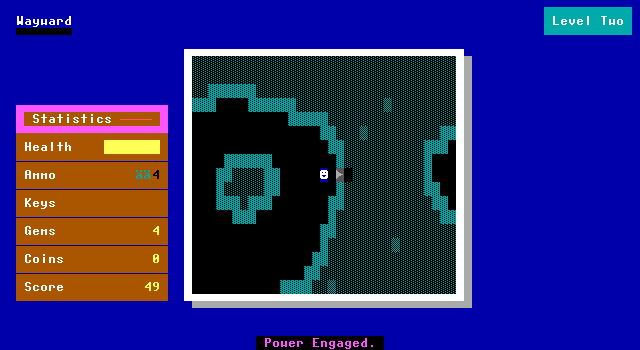
The cavern is sealed, but after throwing a power switch it's possible to activate a drill to burrow through the walls.
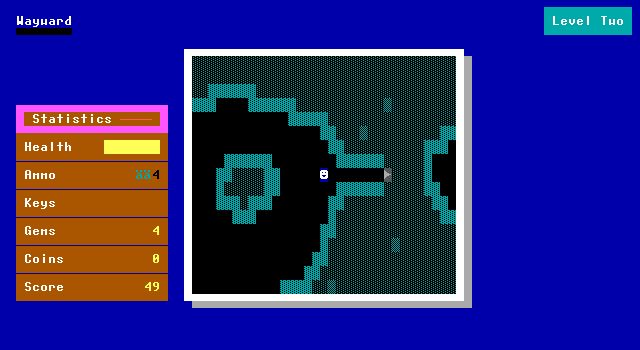
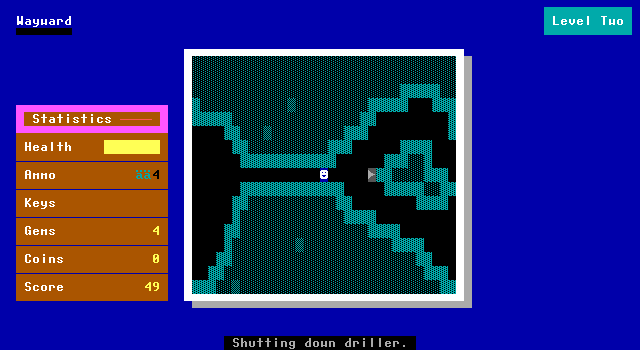
The driller tunnels its way across, making clean matching walls that wouldn't be directly possible in ZZT or Super ZZT (though you could place ammo and then turn that ammo into a wall to obtain dark cyan).
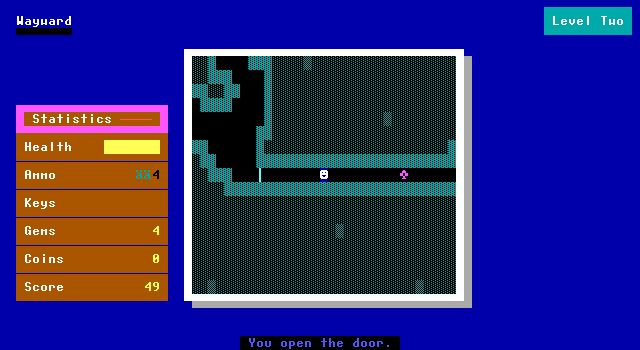
More ruffians lie ahead along with the exit from the cavern.
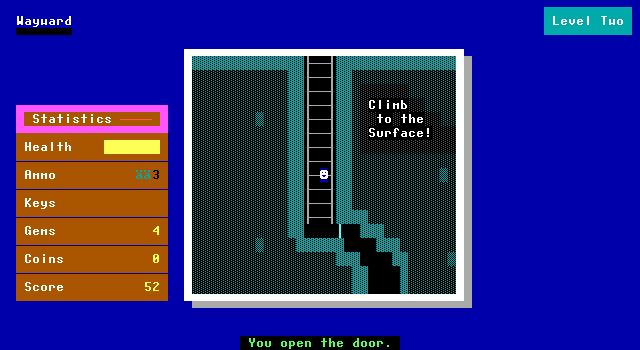
A large ladder leads the player upward, placing them back on the surface of Wayward.

The game shifts perspective momentarily, changing from an overhead view to a side, constraining the player from moving up, which would now be moving into the air.
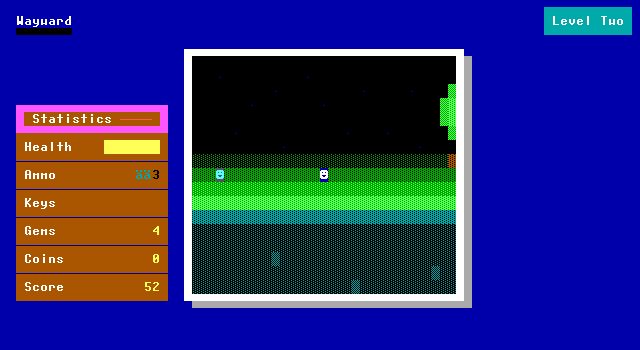
There's a short walk through the grass before another run in with the jester.
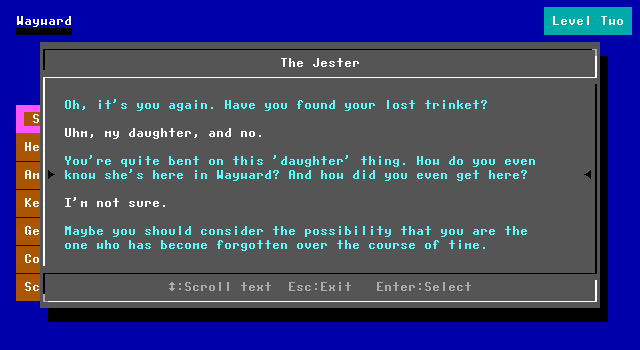
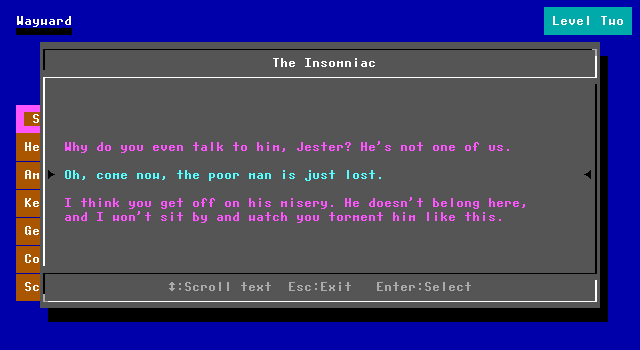
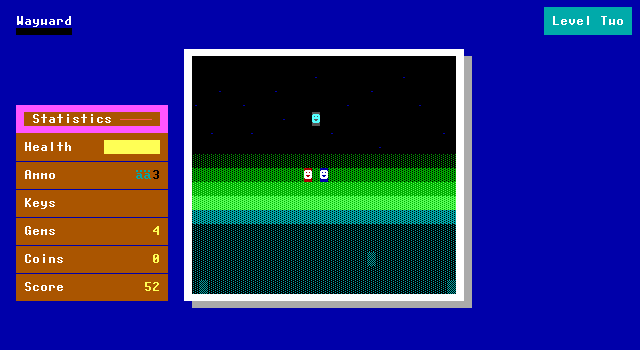
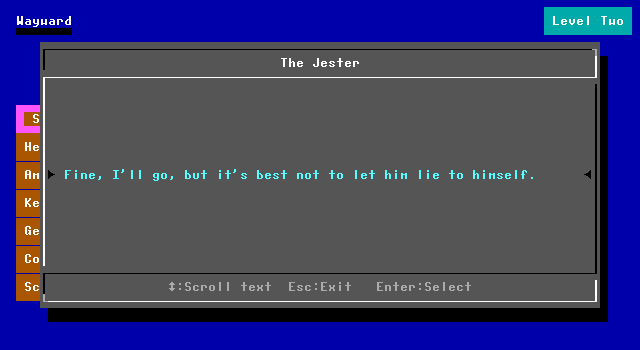
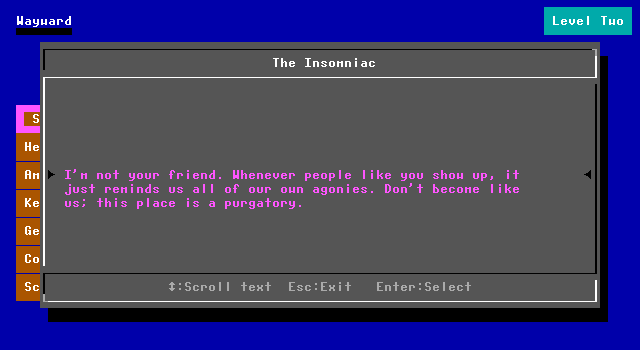
The jester once again brings up the idea that maybe Forrester is the one that has been forgotten, but the insomniac shows up and won't hear of it. He quickly admits that he doesn't want Forrester to end up like any of them. The jester takes off into the sky and vanishes, and the insomniac also walks off into the distance to disappear and let the player continue their search for Forrester's daughter.
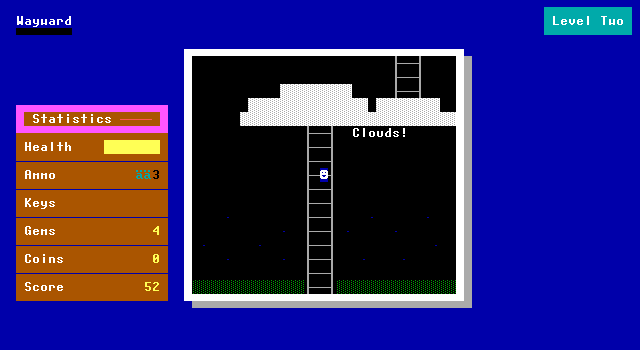
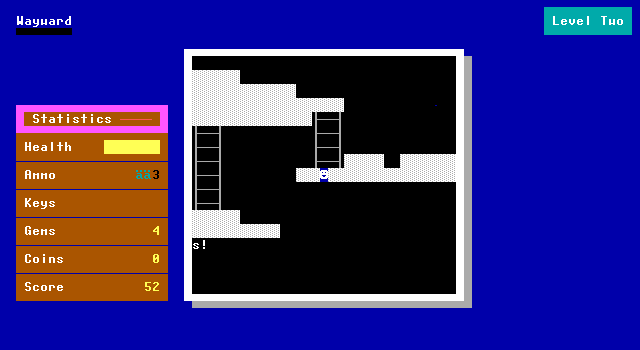
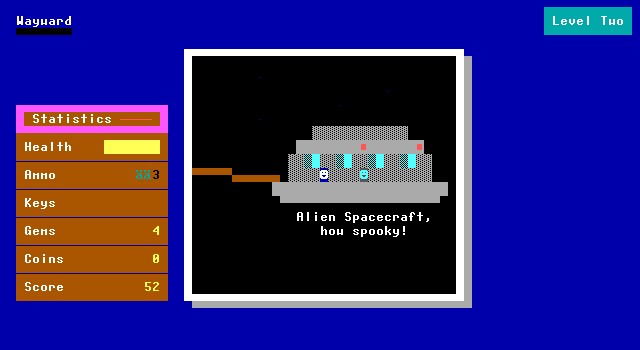
Another ladder leads upwards into the clouds and across a rope into a UFO! There's no alien inside however, it's just the jester once more.

The jester once more tries to convince Forrester that it's a good thing to be forgotten for the freedom it gives you. He them walks off the ship and floats into the sky once more. Forrester has no place to go but to follow.

Up even further is the third level. The player is pushed upwards automatically here, floating just as the jester did moments before.
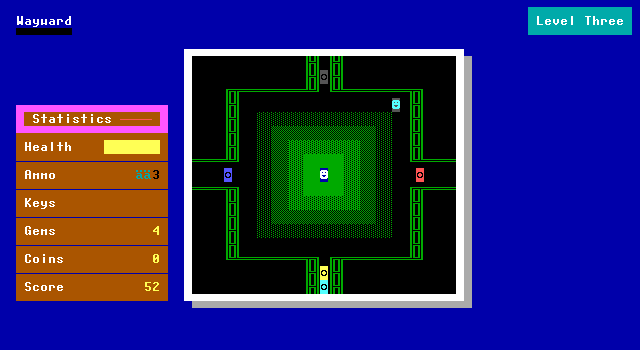
It's time to play some games with the jester.
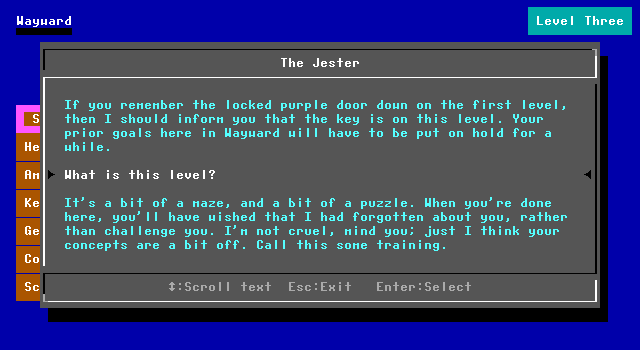
To convince Forrester, the jester decides to play a few games with him to get him to understand how nice it is to be forgotten. There are several locked doors the player needs to solve puzzles and challenges to get the keys for.
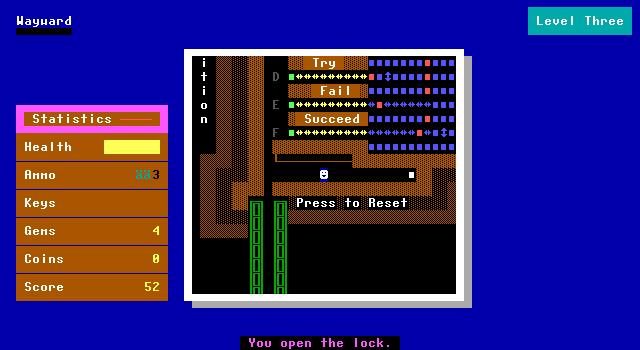
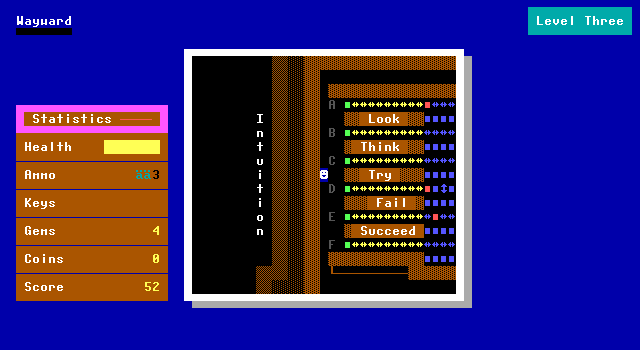
The first puzzle is a combination puzzle like Town of ZZT's bank. To input the combination, the player needs to line up the red boulders so that a pusher can move everything aside.
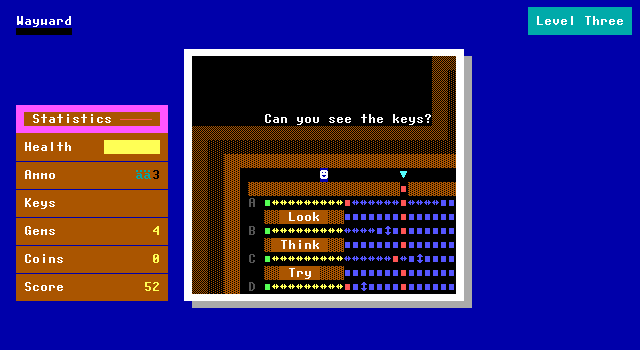
This just involves scrolling the screen and remembering how many spaces to push each row of sliders the proper amount. It's not much of a puzzle, but it's not really trying to be one.
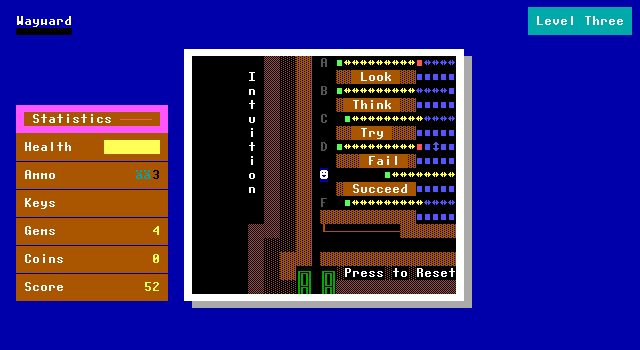
After entering the combination, I managed to accidentally step on one of the letters. MegaZeux allows for custom floors of any character, and in my own ZZT-centric mindset, I didn't once think I'd be able to stand on top of the letters.
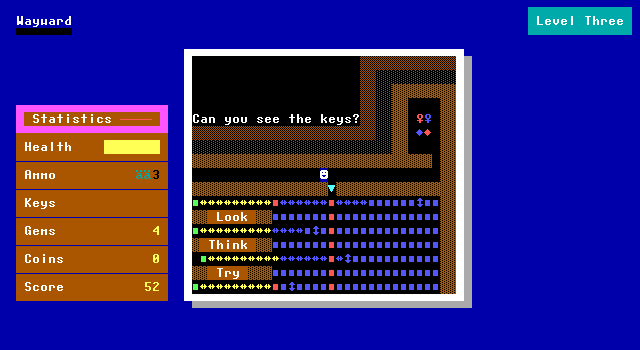
The player gets two keys for finishing this puzzle, and hears from the Jester once more before being able to collect them.
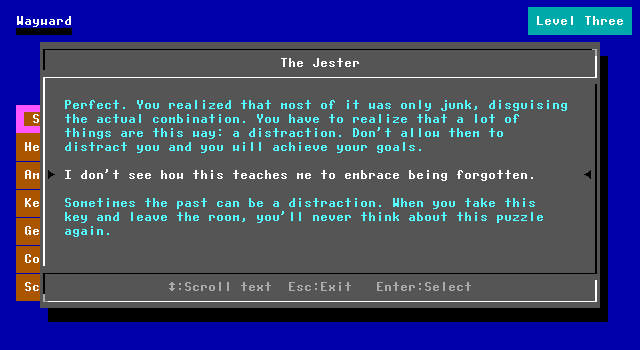
According to the jester, the past is a distraction getting in the way of living one's life.
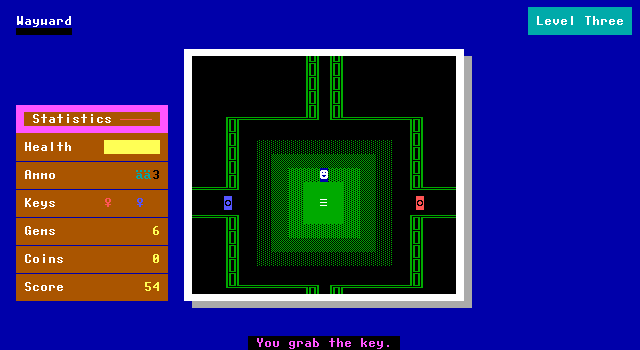
The two keys can be used to try two different puzzles next. Let's take a look at the one on the right first.
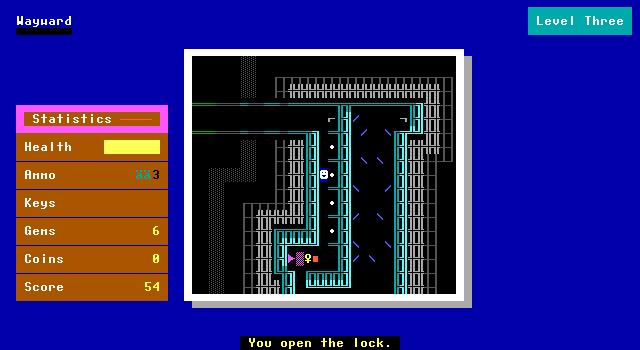
The right path is another simple puzzle involving ricocheting a bullet into a breakable way to let the player collect the key. The buttons each rotate some of the walls to change how the bullet deflects, and the gun causes the gun in the puzzle to fire.
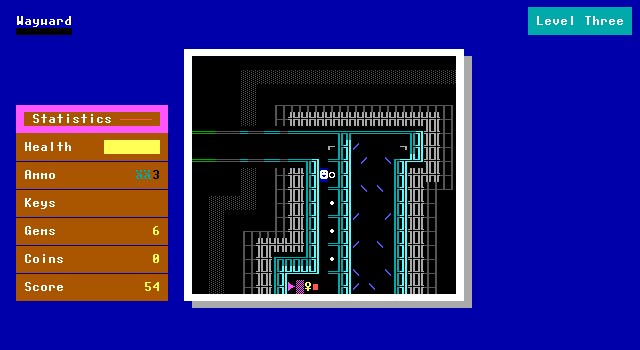
Oddly, only the first button changes characters as you toggle its state. The rest all alter the puzzle, but always remain closed circles. Again, like the combination lock, it doesn't take very long to clear the puzzle and collect its key.
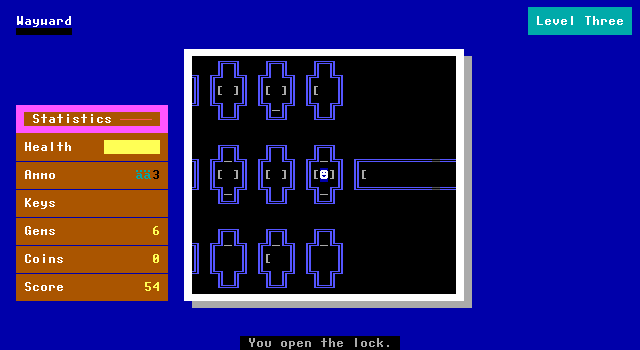

On the left path is a transporter maze. The player warps from room to room trying to work their way to the exit. It's not a hard puzzle either, but is a bit more confusing as the maze only has three visible rows, but four rows total. When you transport up and down, the camera stays focused on the player so it looks as if the player isn't moving, but transporters are. Once you get your bearings however, it's straightforward.
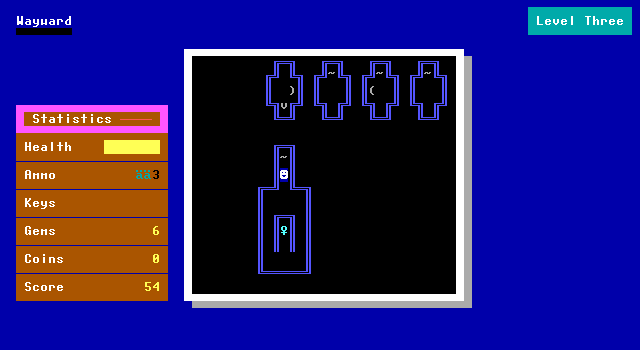
The puzzle leads to the last key to collect, letting the player escape from the jester's games and resume their own quest.

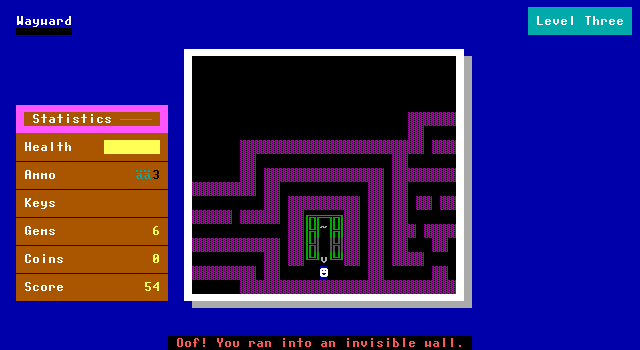
Or perhaps not! After a short river ride, the player is dumped into an invisible maze. Fortunately it's the "improved" kind where hitting any wall in the maze causes the entire thing to flash momentarily.
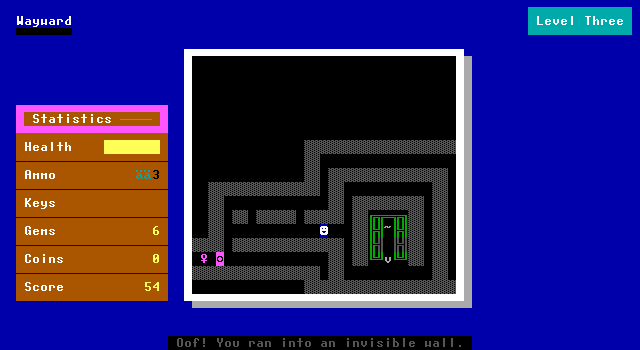
The maze requires obtaining a key before being able to exit, but like all the other puzzles so far has been very simple to grasp.
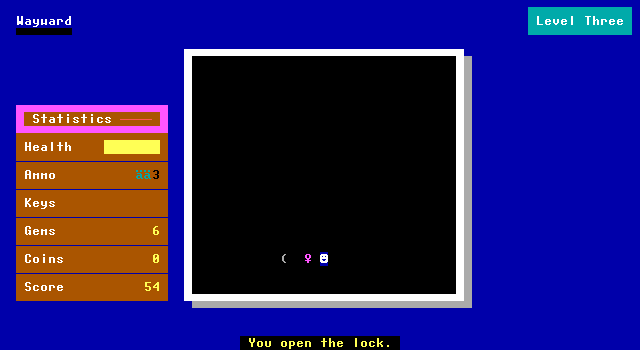
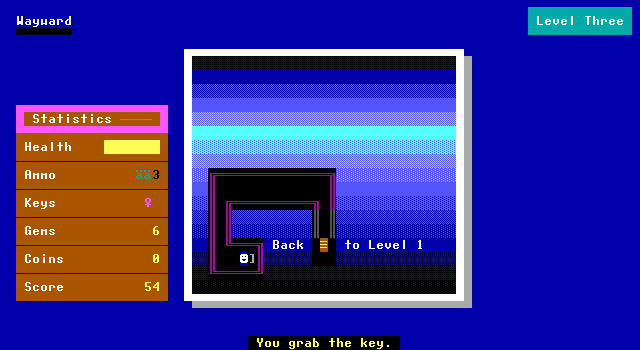
Finally Forrester is actually free and obtains the key to the fourth level.
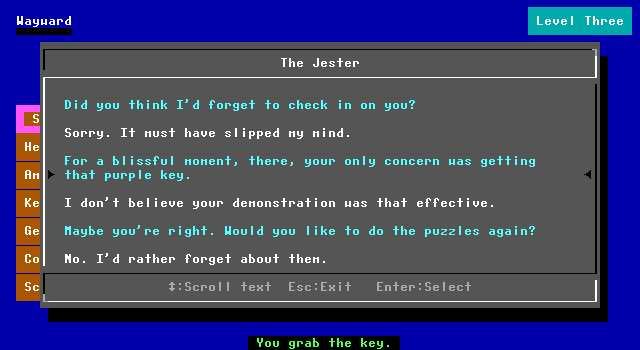

Those not very exciting puzzles weren't exciting for a reason! Everybody has something they'd prefer to forget about.
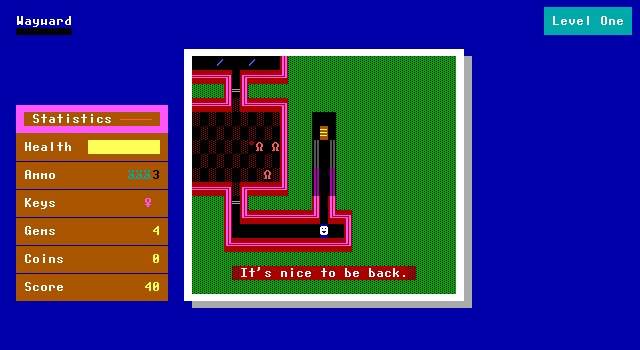
The passage out leads back to the hub, but some lions need to be dealt with first.
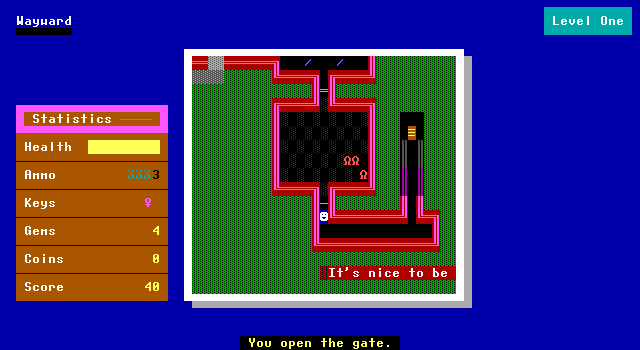
One nice built-in element MegaZeux offers creators is a gate. Touching them makes them open for a brief period, allowing the player to move on through before it closes once more. This is a nicer alternative to ZZT's transporters which need multiple tiles to become two-way or swinging door objects which have to push things around and can potentially get blocked.

After getting past the lions, there's a pusher train which will carry the player forwards without any interaction from them. These are essential for automatic Mario levels.
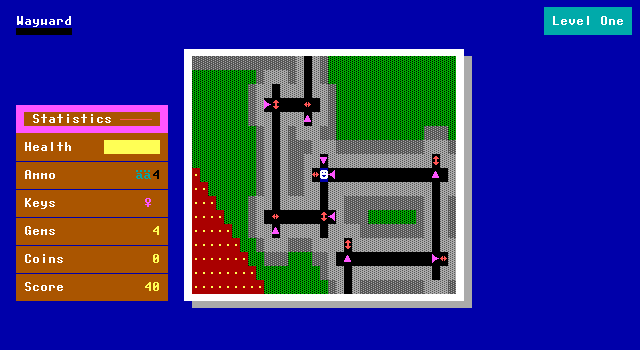
The train has a lot of bends along the track.
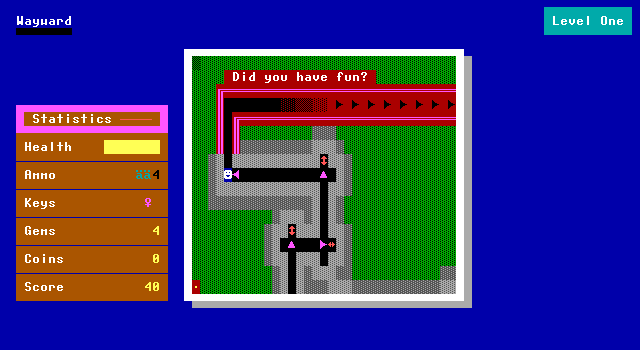
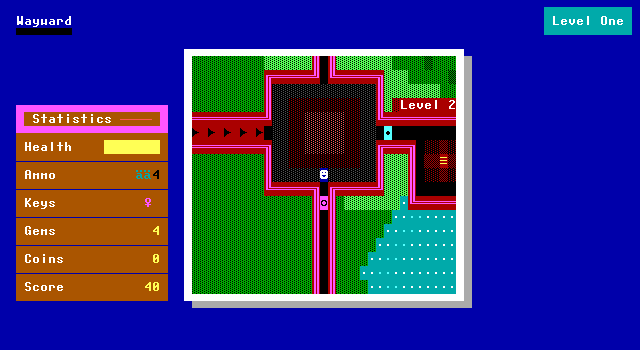
Eventually the player has to take control once more, moving towards another river that leads right back to the very start of the game with the purple door to level four right there.
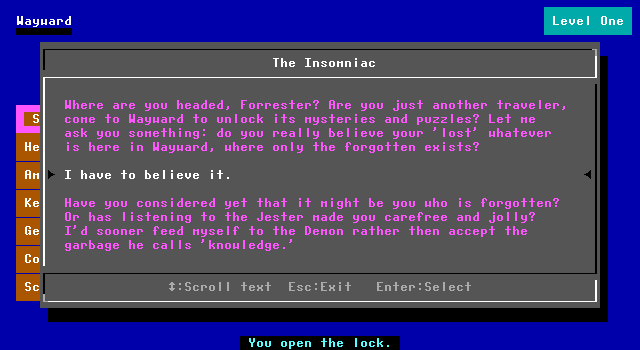
Of course, as always the player is interrupted before they can proceed. This time by the insomniac.

Again the idea that its Forrester who has been forgotten is brought up. This is also the first mentioning of the demon, a character yet to be met.
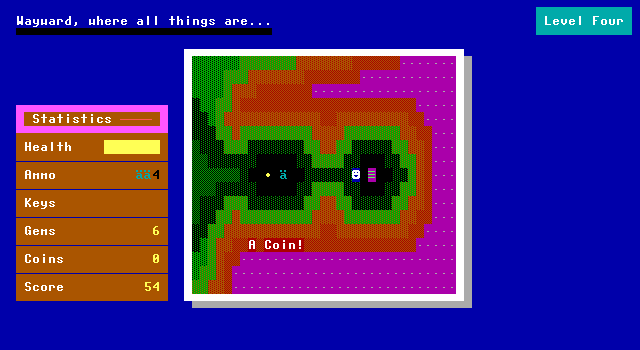
A passage leads to level four and the text on the overlay changes from just "Wayward" to "Wayward, where all things are..."
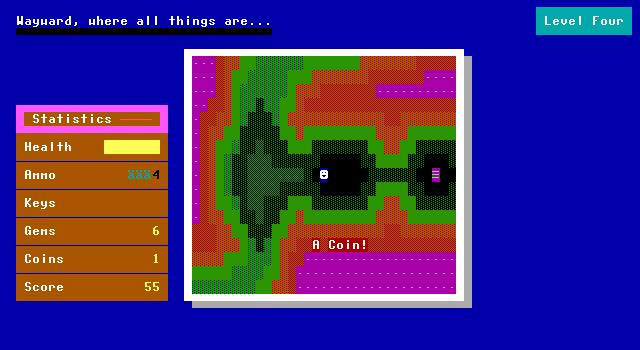
Right away the player picks up a coin. Coins are a default item in MegaZeux to help break down the role of gems in ZZT games. Gems give health, score, and often get used as currency in ZZT worlds resulting in objects needing to be used if any of those functions is undesirable. MegaZeux adds coins to decouple health and currency.

The forests of Forrester's fourth force Forrester to mark his path with a trail with forest tiles that work like those in (Super) ZZT. Creatures can't make their way through the forests, but the player can, opening up routes of travel for any monsters in the woods.
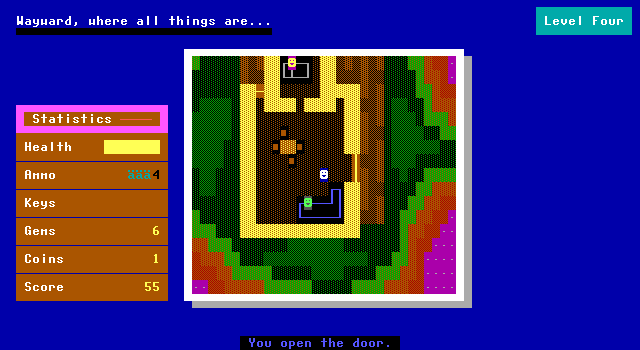
A cabin in the forest introduces a few new NPCs.

On the couch is somebody who will sell a necessary key for 20 coins.
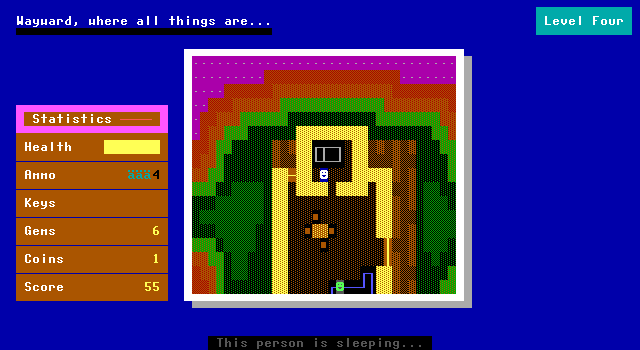
On the bed is somebody who was sleeping, but disappears as soon as Forrester interacts with them. The wireframe looking furniture here looks quite different from how most furniture is depicted in ZZT games.
Down the path Forrester runs into the insomniac yet again.
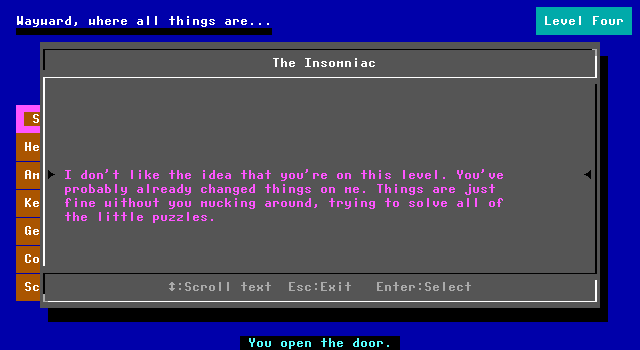
And he is not pleased that Forrester is here, changing the environment through his interactions within Wayward.
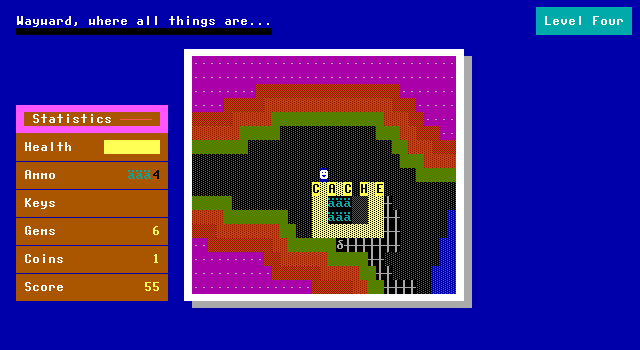
Continuing down one of the paths is a cache of ammo and some spiders on a web. The spiders are confined to web tiles like in Super ZZT, but the webs are actually less complex, always using the same cross character regardless of what they're bordered by. Super ZZT draws the characters based on what tiles they're surrounded by that are also webs.
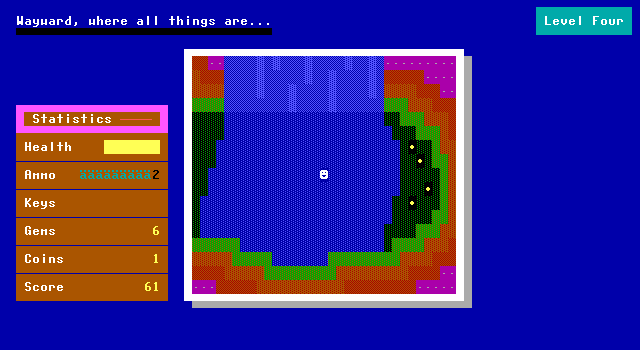
All of this is across a static waterfall with a few coins on the other side.
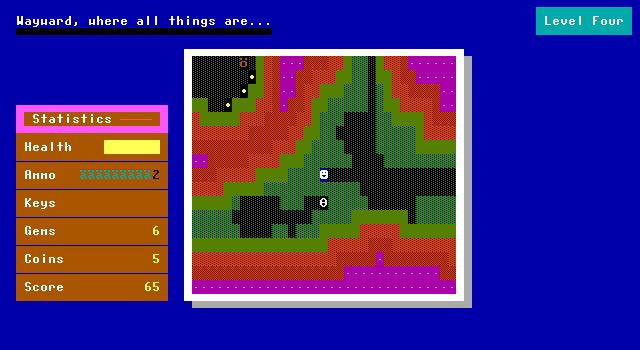
A lone centipede head is here. MegaZeux doesn't have centipedes, and I'm not at all surprised that this centipede has no segments attached. Centipedes are strangely intricate enemies in ZZT, eschewing the usual method of updating elements on a board by going stat by stat, and instead having special leader/follower internal properties to make the whole creature move around.
It's possible in ZZT to construct a fake centipede out of objects, but only if it never turns around due to the stat ordering causing a traffic jam as one object wanting to move can't until the after the next object that want to move does so, resulting in very broken up steps rather than the smooth movements of actual centipedes.
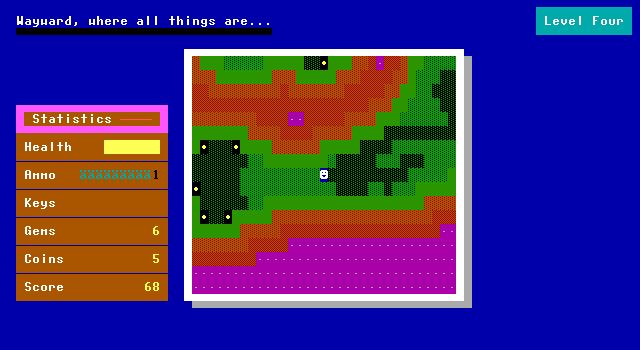
There are yet more coins to collect up ahead.
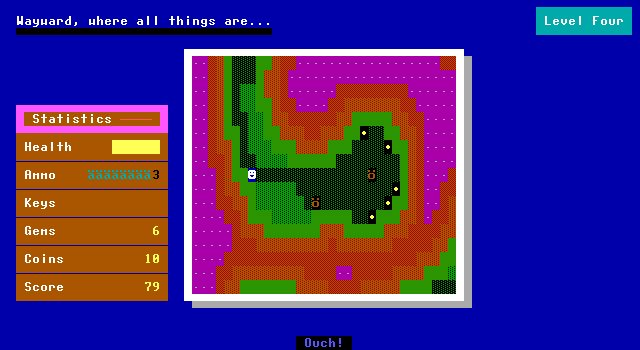
Another branch of the forest features bears, which act like ZZT's, only moving when the player is aligned with them to a certain degree based on their sensitivity. Perhaps they're meant to be cubs, since they use a lowercase o rather than a capital one.
Super ZZT's bears have an identity crisis where they've been replaced with dark green snakes, but are still called bears in the game's editor and when referencing them with ZZT-OOP. It's an even stranger decision to call them snakes when even Monster Zoo itself calls centipedes snakes. Super ZZT likes its reptiles.
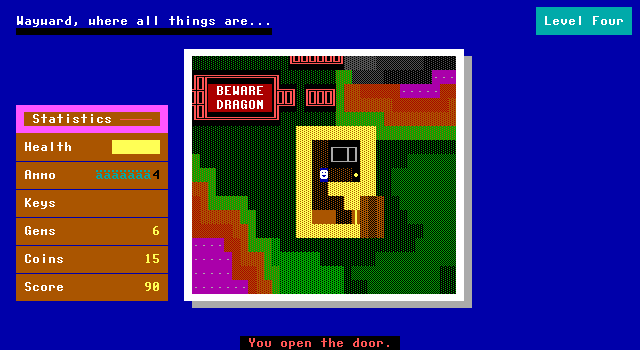
Speaking of reptiles, another path leads to an abandoned house with a single coin and a large sign warning about a dragon.
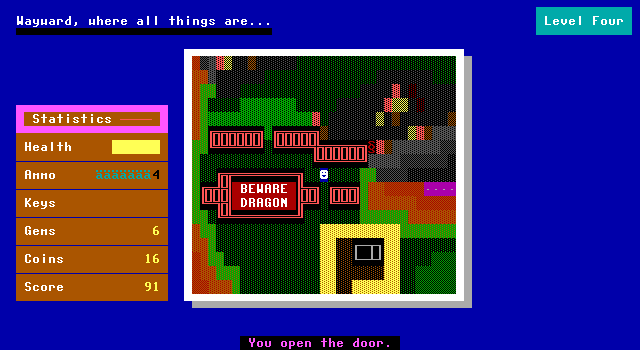
The dragon takes on the appearance of dragon enemies in Town of ZZT where they're made out of objects. Super ZZT introduces the very peculiar "dragon pup" enemy, which... doesn't move or attack at all. Here however, the dragon attacks via spitting fire, a new method of attacking the player in MegaZeux compared to ZZT's bullets and stars. Fire lingers around on the board, damaging the player if they step into it. It will eventually burn out on its own, but it can also spread onto certain tiles.
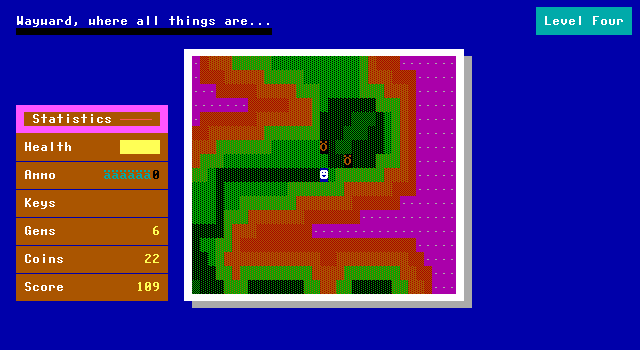
There are some big bears later on, so I suppose those were cubs before. By this point I've hit the 20 coins to buy the key and can head back. There are more than enough scattered around the forest.
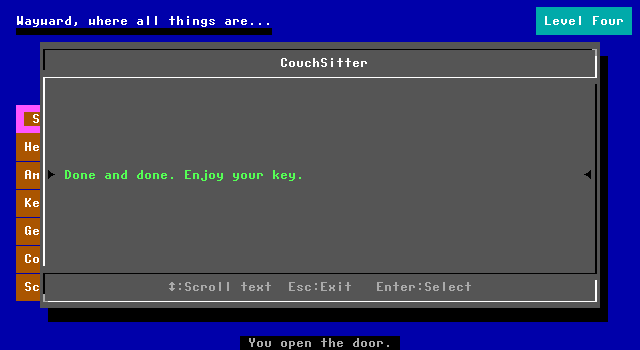
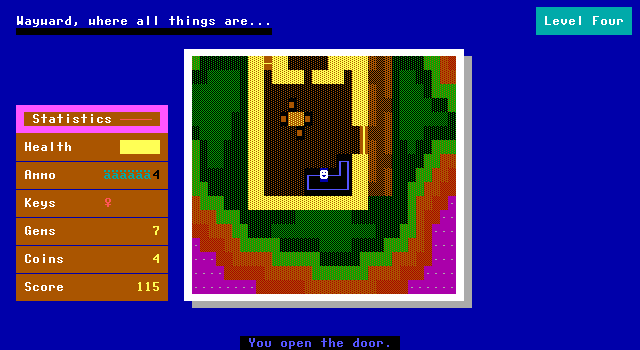
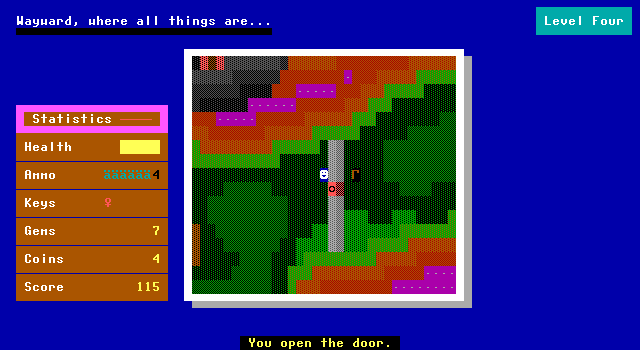
After going back and purchasing the key, the seller vanishes just like the person sleeping on the bed did. Just after opening the door, the insomniac shows up again and is quite upset with the player by this point.
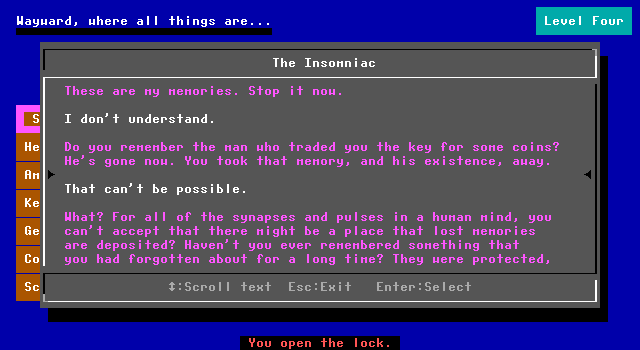
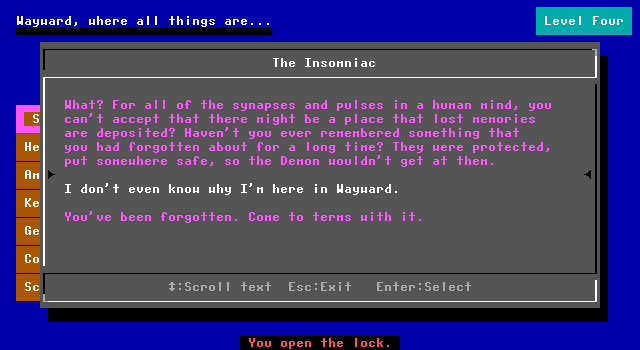
By remembering people in Wayward, they vanish from existence, no longer a forgotten memory. Forrester is unintentionally wrecking the joint in his quest for... something. He can't remember it anymore.
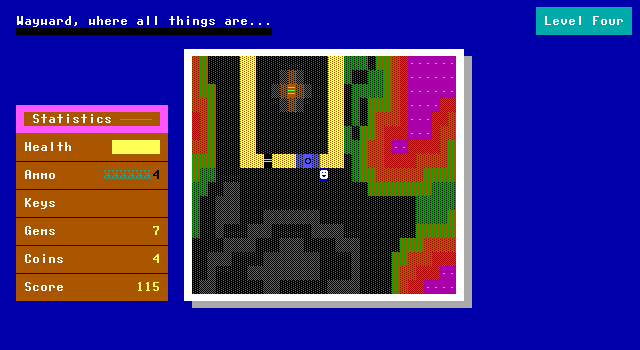
Past the red door is another small building with a blue door. Peeking in the window lets the player know it's the exit from the level. There's only one path to the right to explore in search of this next key.
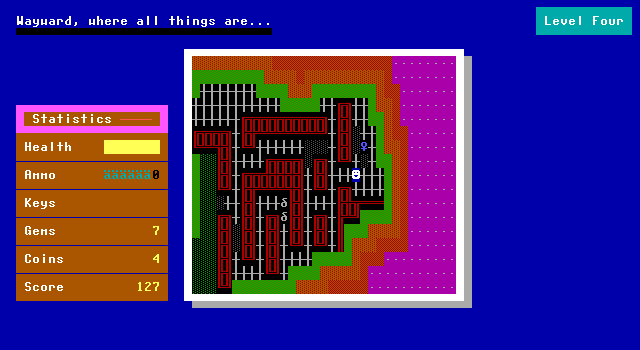
There's one last small maze of spiderwebs to navigate to collect that key and continue moving on. Progress has to be made after all.
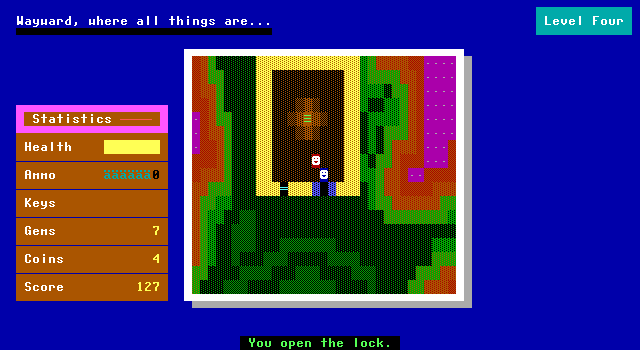
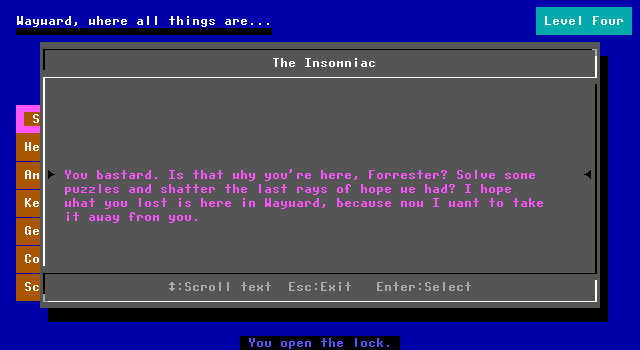

Level five brings another change to the text on the HUD to "forever lost".

The path leads to a flipped version of the UFO from earlier in the game.
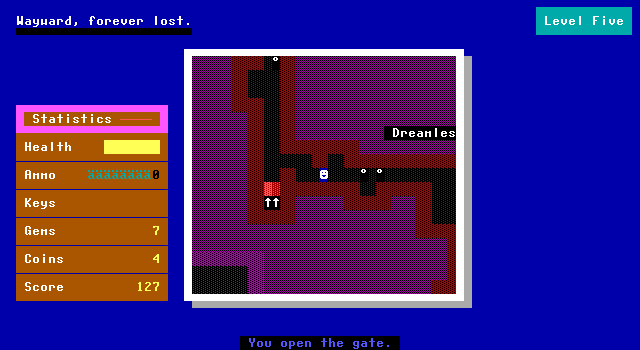
And then a few spinning guns whose bullets need to be dodged by ducking into small alcoves off the main path.
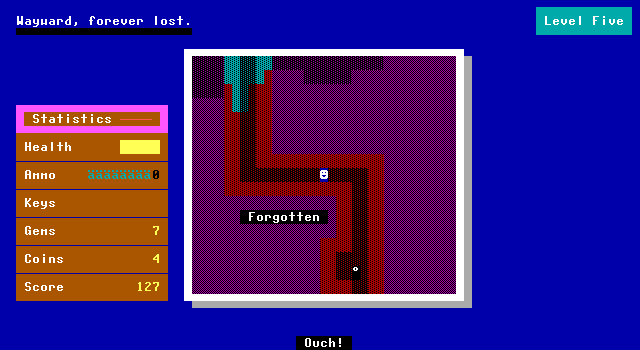

After a short walk the player meets up again with the jester. This time he too is upset with Forrester's behavior in Wayward.
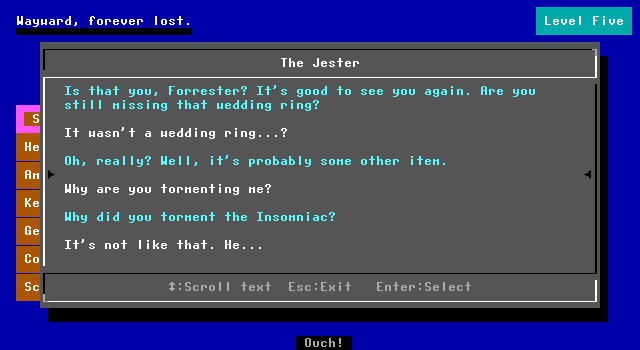
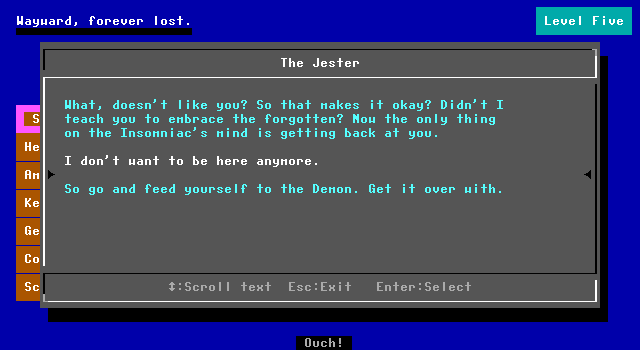
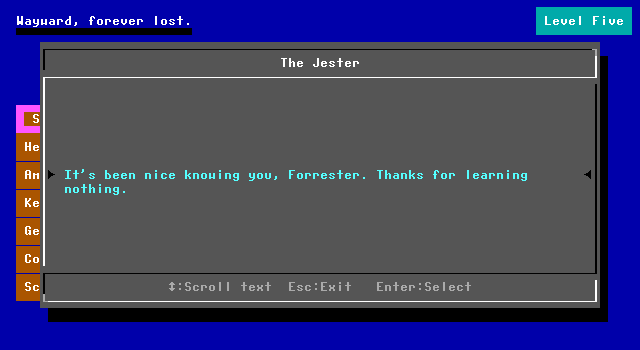
Forrester has forgotten his purpose and just wants to get out of Wayward. Unfortunately for him, the only way he can do that himself is to be killed by the demon.


This is followed up by a huge section loaded with ruffians to get past.
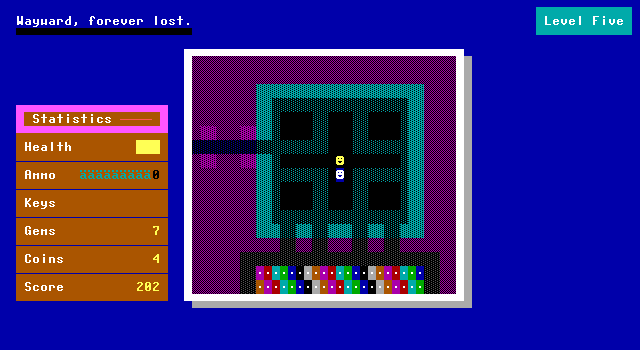


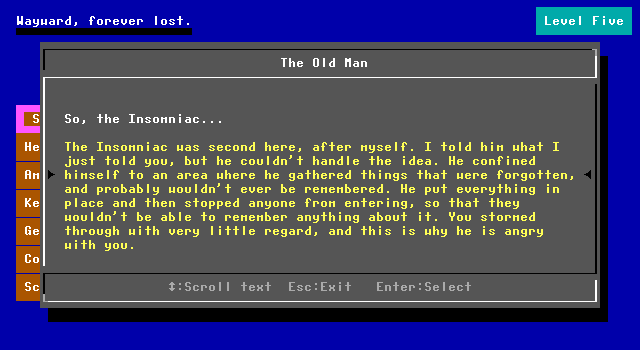
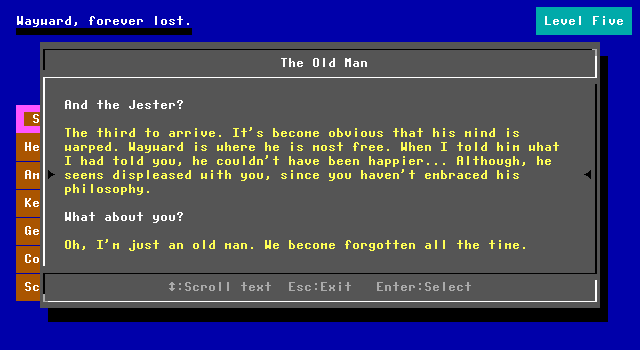
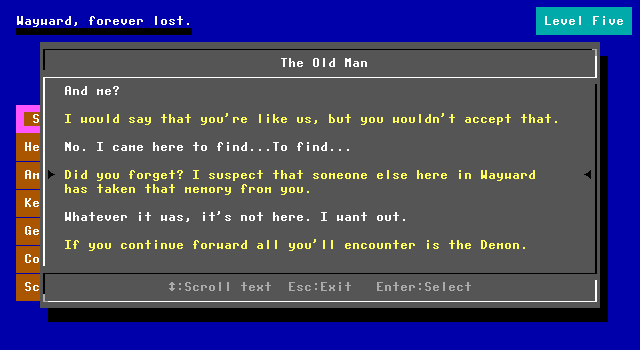
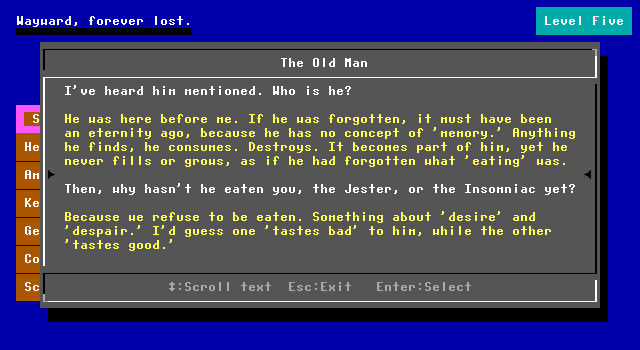
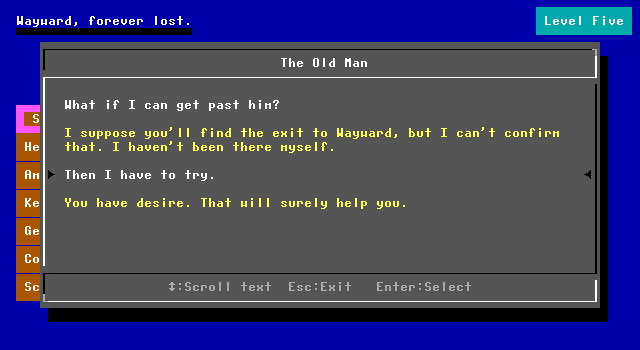
There's an enlightening conversation with the old man. The insomniac was trying to hide memories so they couldn't be remembered until Forrester just ran through and wrecked the joint. It seems likely that as revenge the insomniac took away the memory of Forrester's search for his daughter, leaving him with no purpose in Wayward.
The demon meanwhile will destroy anything he eats, but will only eat those who have given up. Forrester still has hope though, and opts to try to get past the demon in hopes of finding an exit from Wayward.
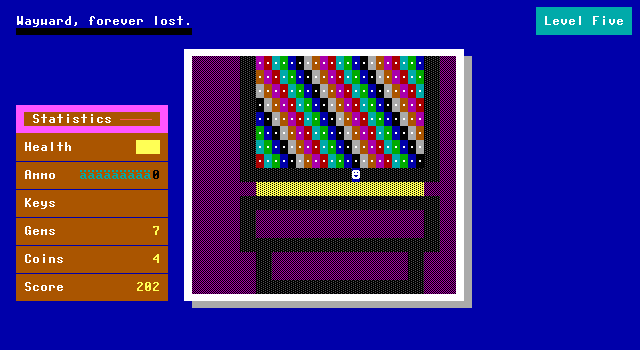
There's a block of classic Super ZZT rainbow bands in the next room. Here I assumed they'd be floors, but there were actually solid walls. Similarly, there's a yellow border along the southern edge of the room which can't be passed, forcing Forrester to turn back around.
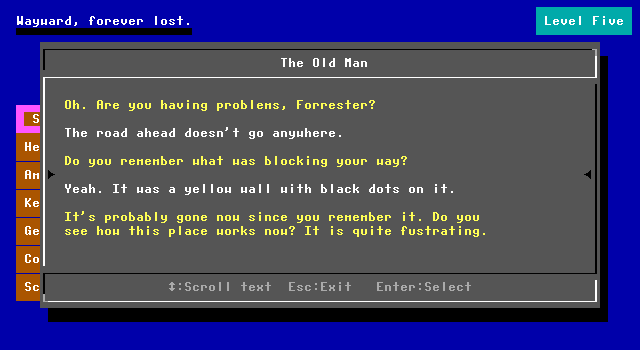
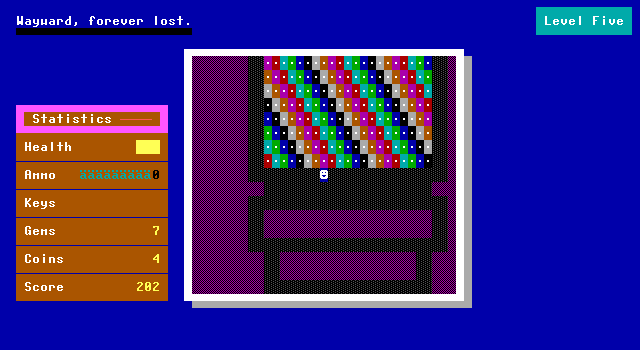
The power of remembering comes into play, causing the wall to disappear when Forrester recalls it.
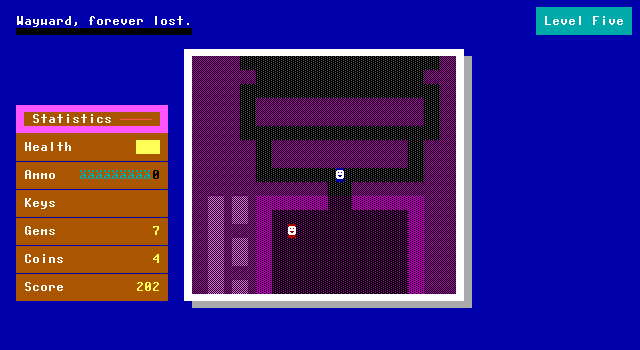
With the wall out of the way, Forrester proceeds into another room with the insomniac.
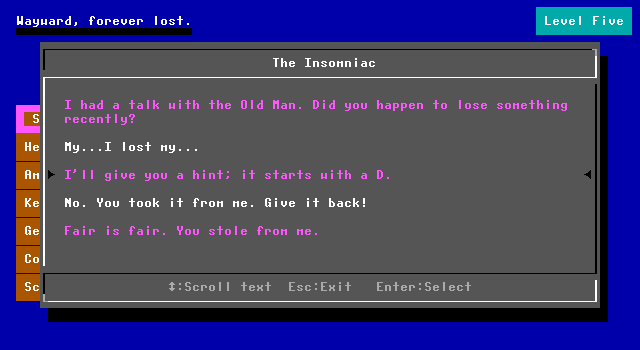
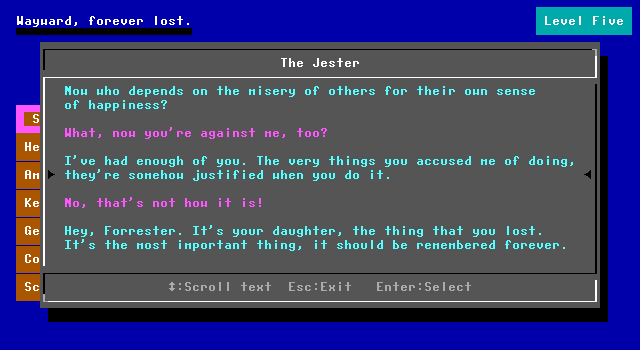
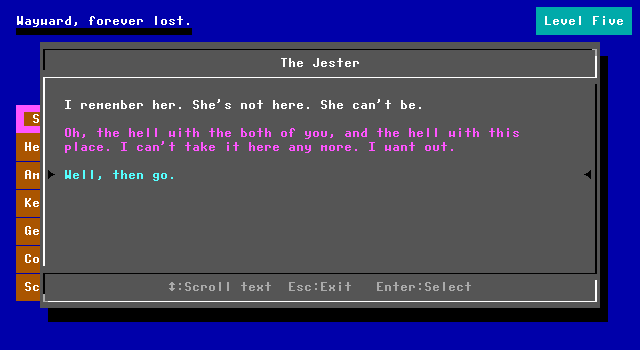
The insomniac taunts Forrester about the stolen memory. Fortunately for him the jester arrives and calls out the insomniac on his cruel behavior. Frustrated, the insomniac gives up on everything and opts to offer himself up to the demon.
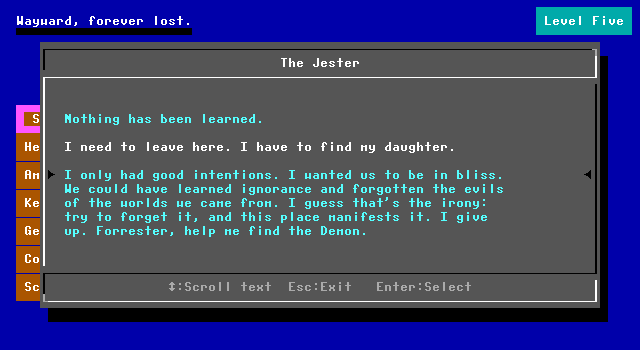
The jester too is tired of everything and intends to find the demon as well. It's a very unhappy time for everyone.

The jester actually follows Forrester at this point, always maintaining some personal space, which is nice compared to ZZT where you can make an object follow the player, but always blocking one of the spaces around them. Here there's no loss of mobility.
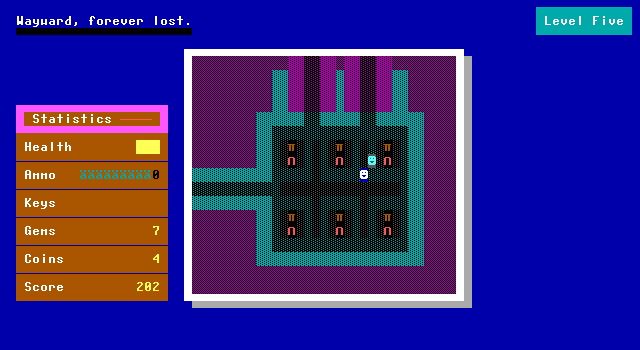
The duo pass through this chamber, but nothing can be interacted with. I'm not exactly sure what the objects are supposed to be here.
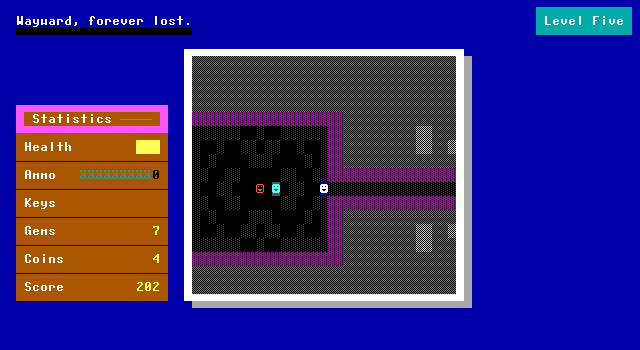
The jester and Forrester's search for the demon doesn't take long to be resolved.
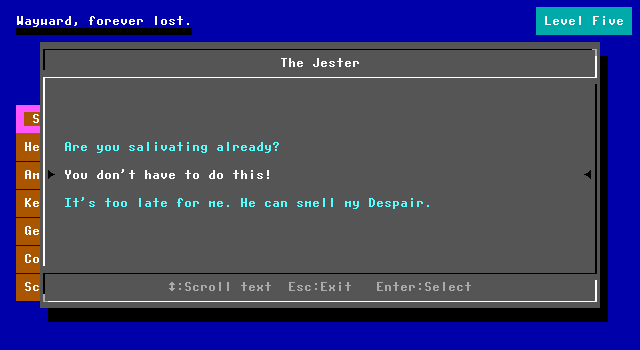
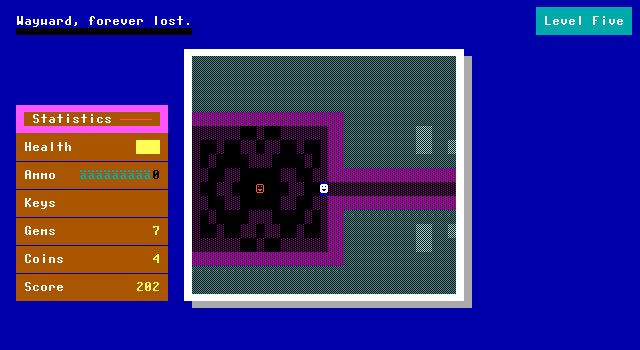
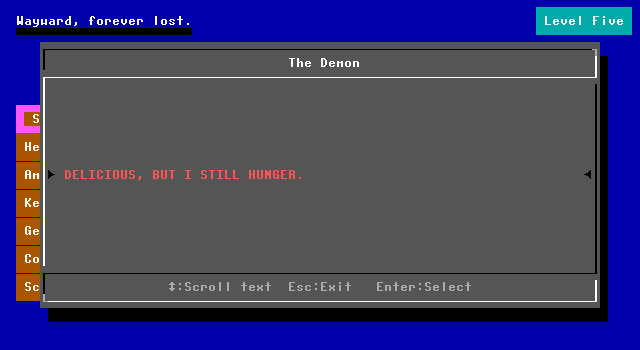
Enter the demon, who consumes the jester and leaves, searching for more beings in despair to destroy.
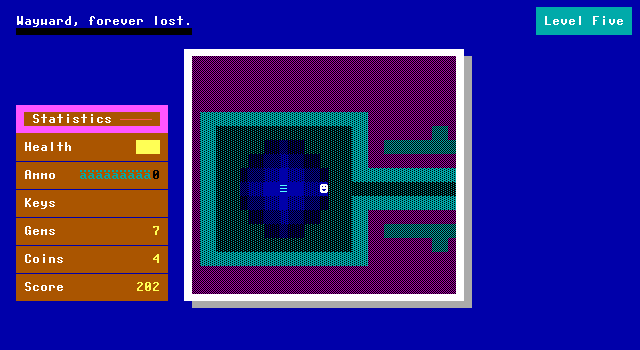
After the jester's demise, the exit to the next level appears.
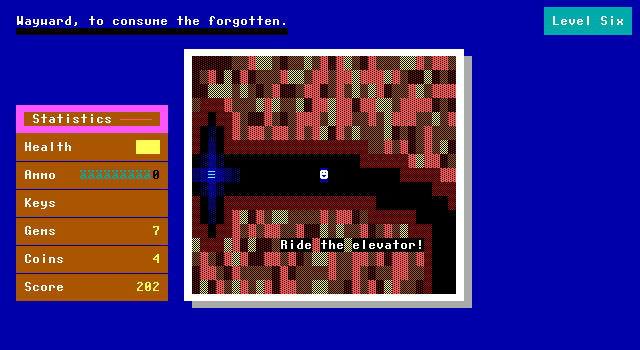
Wayward is having some issues. Again the caption has changed for the new level. The outer limits of the level are filled with fire.
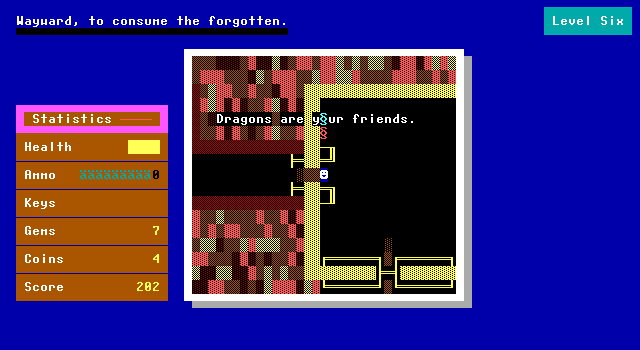
There's a forced fight against two more dragons here, who are most certainly not Forrester's friends.
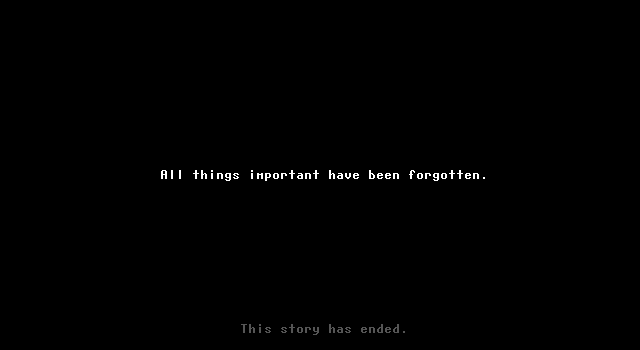
In fact, they managed to kill me. This is the game over screen the player is taken to.
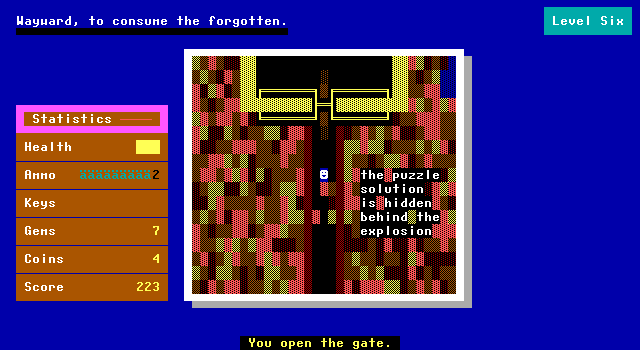
A second attempt fares much better. The outside world is hinting at how to solve puzzles now, and some of the fire has begun to spread inside. Forrester is about to get abstract.
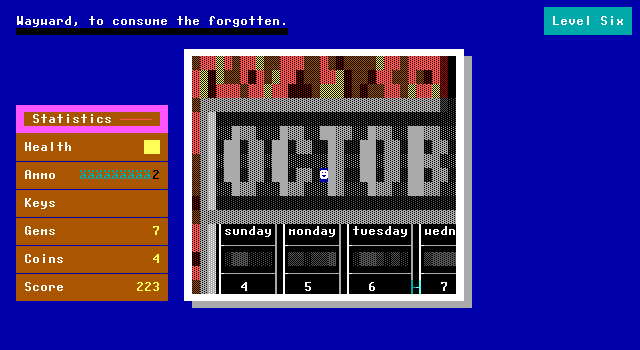

Forrester finds himself on a giant old calendar. Most of it is solid, but the cyan colored tiles can be walked over, making a bit of a maze.
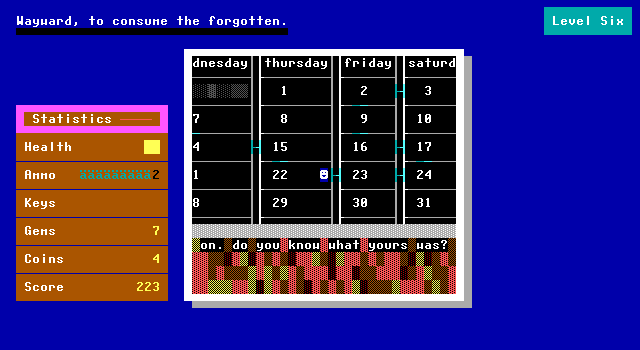
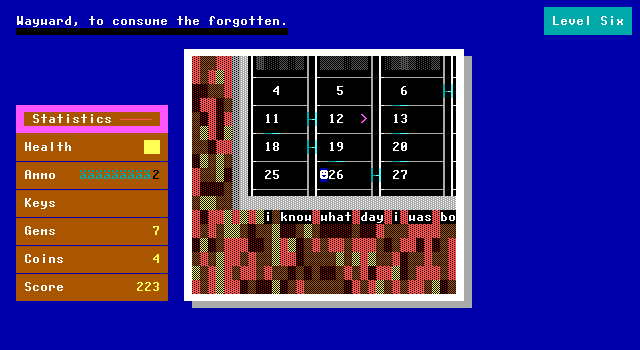
Along the bottom of the calendar is the text "i know what day i was born on. do you know what yours was?"
I guess it's the 12th since that's the only day with a transporter out of the calendar and onto the next area.
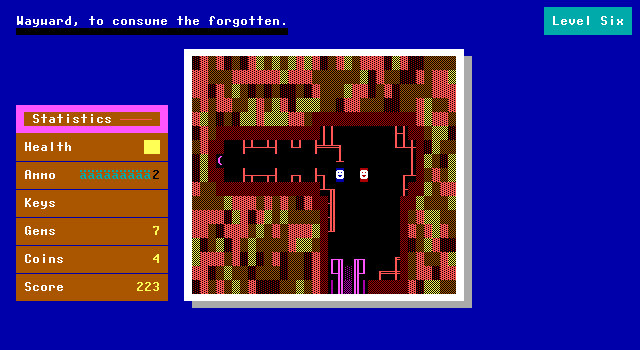

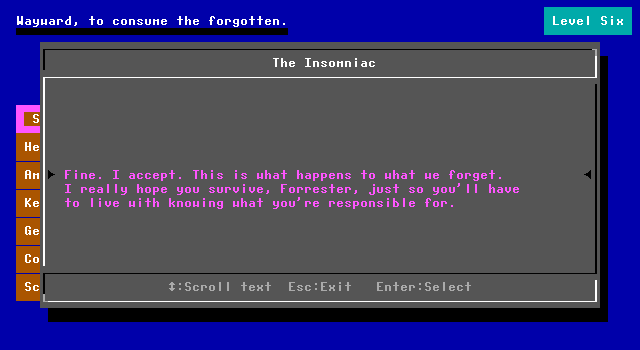
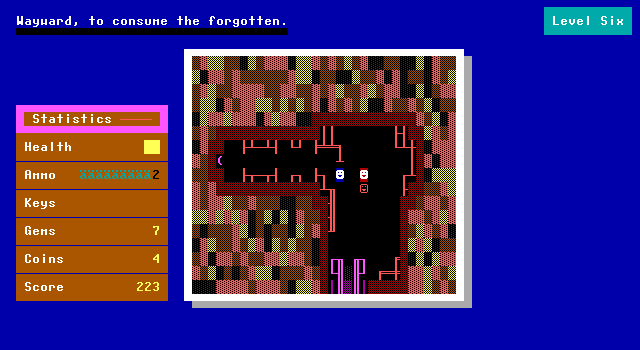
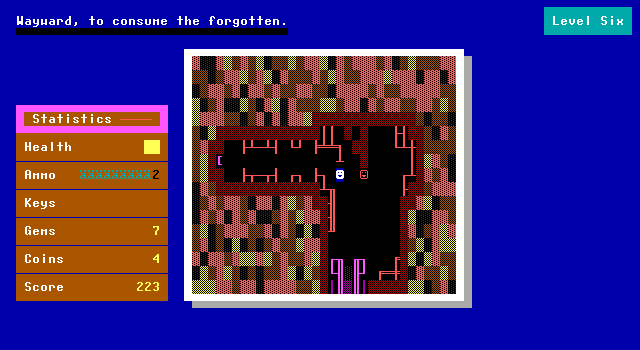
Wayward is really falling apart now. The insomniac gives up and is violently killed by the demon, leaving streaks of blood along the ground.
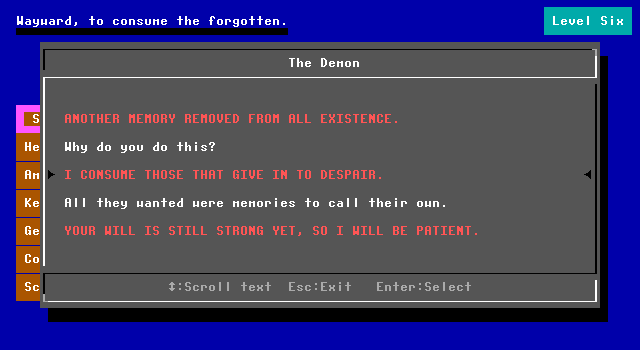
The demon intends to erase Forrester as well, but can't consume those who haven't given up.
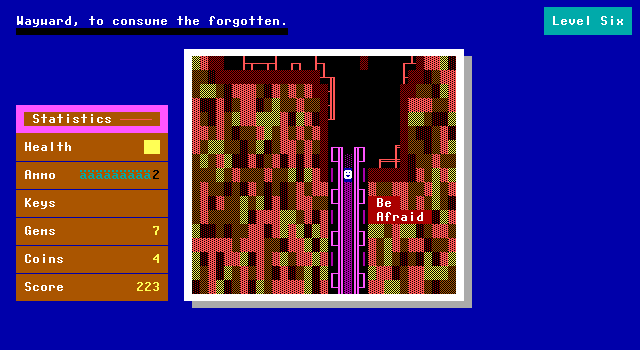
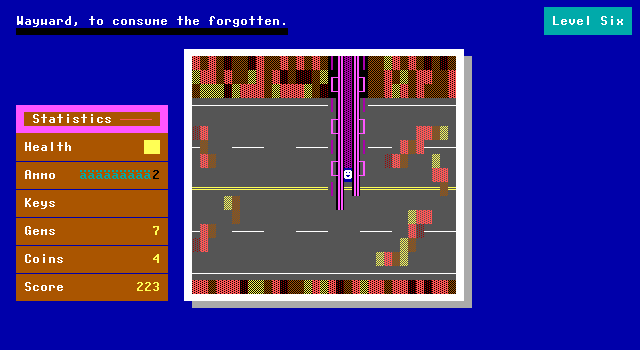
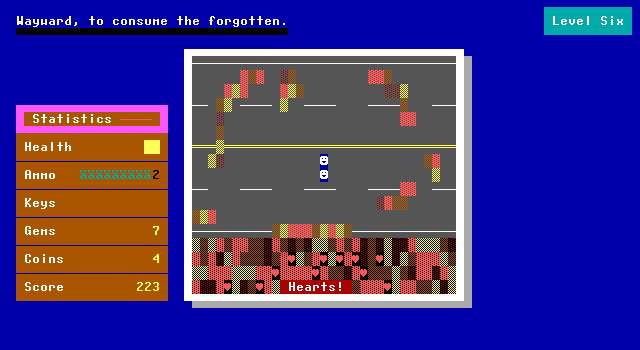
The bridge leads onto what looks like a highway. The road is littered with more fire, and most peculiarly an object that looks identical to Forrester.

The appearance of an object with the same colors as Forrester seems very deliberate. Was this how he was forgotten and brought to Wayward? Was there some sort of car accident to explain all the fire around him? It's unclear what this all actually means, but I don't think an interpretation of Forrester being dead and Wayward being him spending his last moments trying to think about his daughter is too outlandish.
There are some hearts alongside the road in the fire, but venturing in would be certain death.
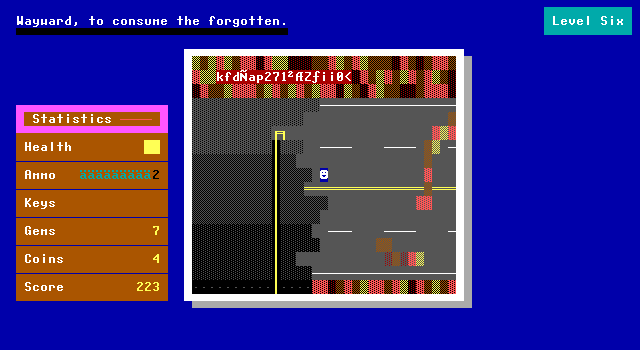
Just past the traveller the road ends, a strange sign is in the fire, and a rope descends downwards into a pit.

The pit has walls lined with lava. While fire rapidly damages a player foolish enough to stand in it, lava instantly kills the player if they don't have any extra lives.

At the end of the lava cave is the demon on his throne.
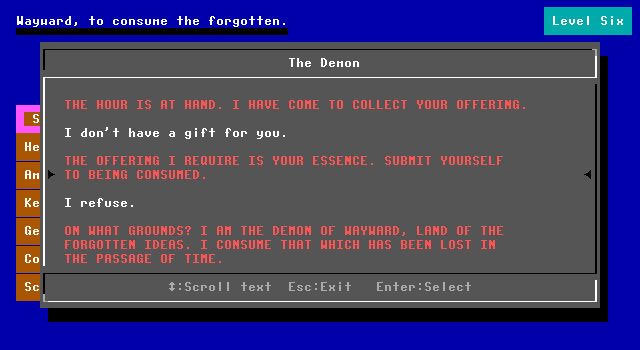
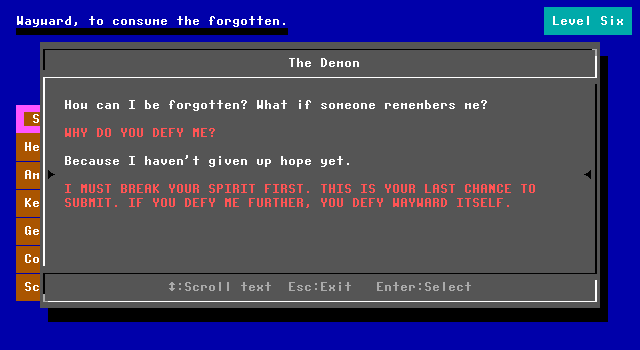
The demon vows to break Forrester's spirit to keep the natural order of Wayward going. He leaves and the passage to the seventh and final level is revealed.
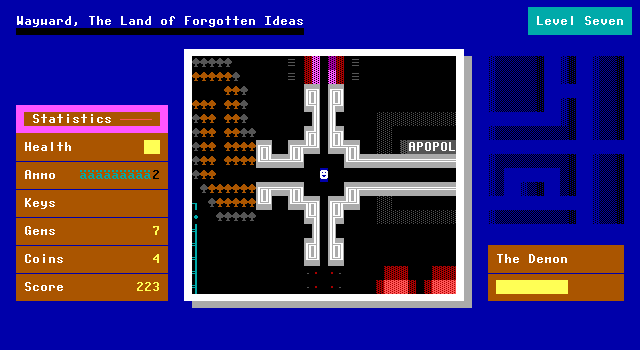
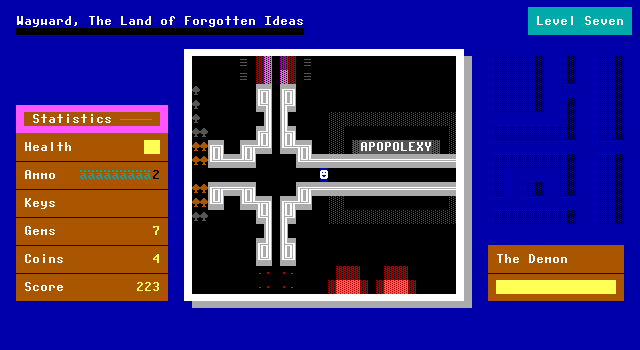
Wayward, The Land of Forgotten Ideas. It's the final level and the player is given their choice of paths to take with the goal of finding and destroying the demon. The HUD also has some odd markings on the normally blank right side of the screen.
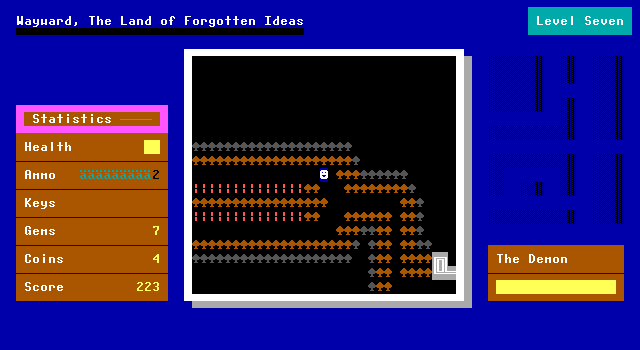
To the west are dead trees and a series of conveyors.
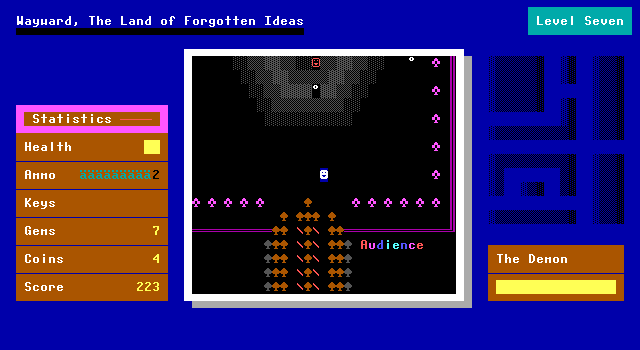
The conveyors carry the player into a small arena with the demon. An audience of ruffians watches the fight. The demon doesn't do anything too complex, just moving and shooting. When he's hit however, he disappears briefly before reappearing elsewhere nearby in order to prevent spamming bullets into him all at once.
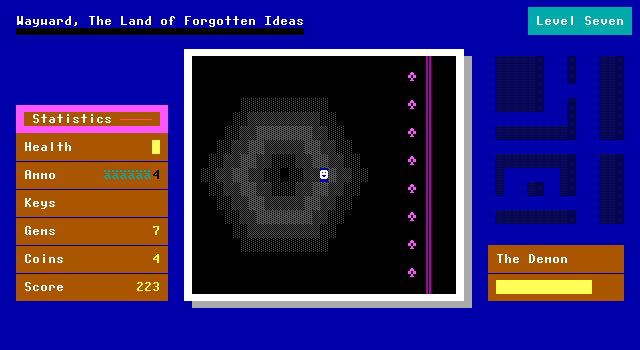
After dealing enough damage to the demon, he disappears from the arena entirely, and the player has to search for him on a new path.
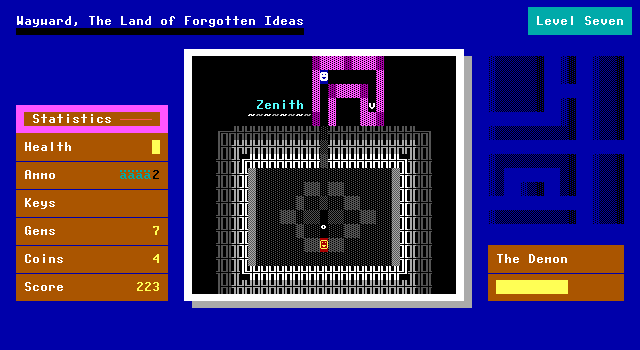
To the north is a purple passageway which leads to a second, much smaller arena by way of transporter. In this phase of the fight it's easy to just stand safely outside of it and shoot inward until the next phase ends.
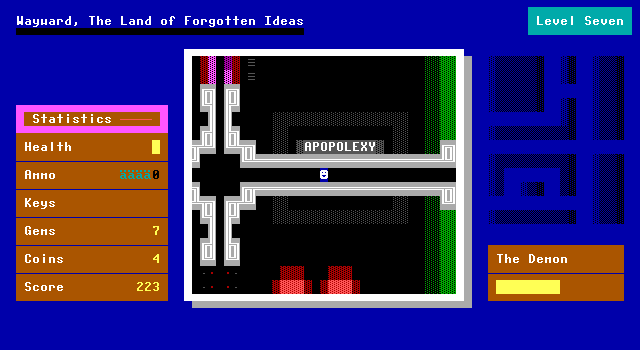
To the east, is the word "apopolexy". Oh dear.
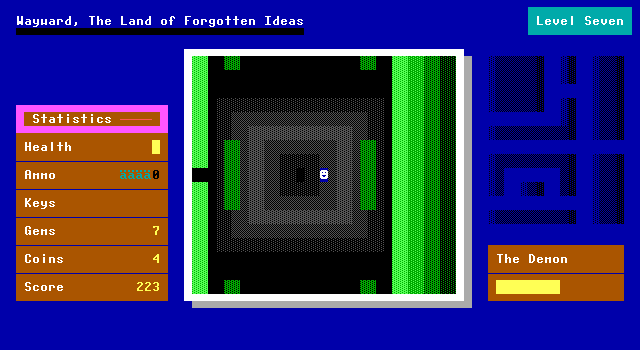
There's a more vertically oriented arena, but no demon to be found.
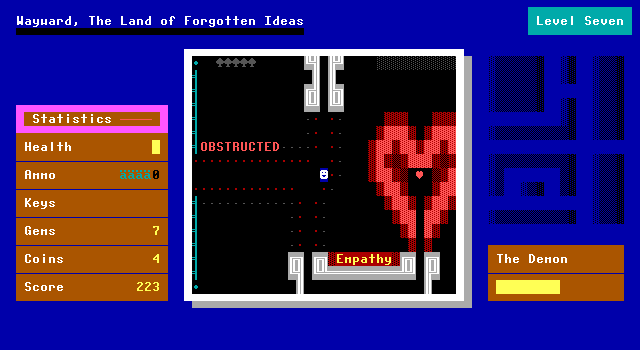
To the south, the path splits further. Near the empathy text is a large heart which contains a regenerating heart powerup within. It takes awhile to respawn so if you're low on health and want to restore it a noticeable amount, you'll be in for quite a wait.
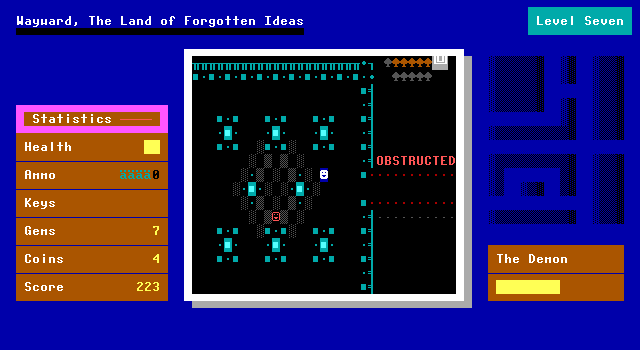
The next arena has the demon and a series of walls blocking sightlines. This makes it difficult to get in a good shot against the demon.
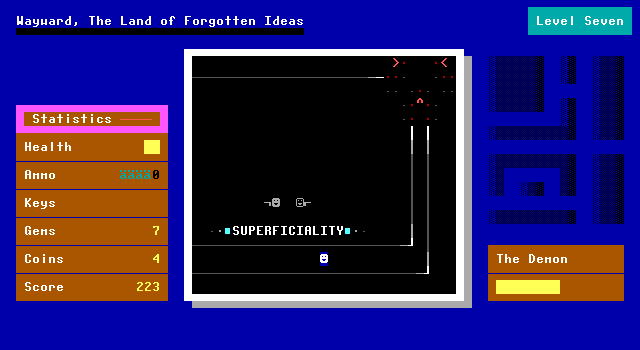
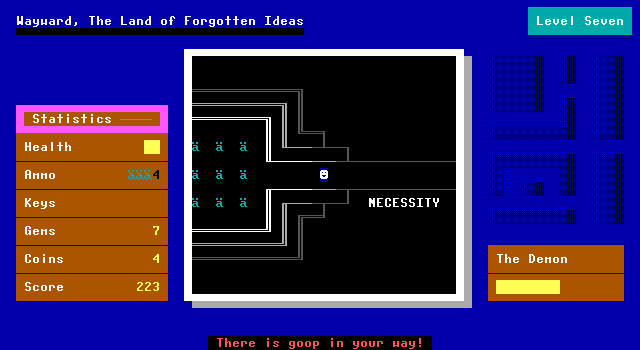
The other path contains more concepts outside the walls. Superficiality and necessity. Superficiality is just that, a path that leads right back to the same path necessity takes, making it pointless.
Necessity thankfully contains several ammo items which respawn almost immediately after being collected, at the very least the fight with the demon can't become impossible to win with these infinite sources of health and ammo.
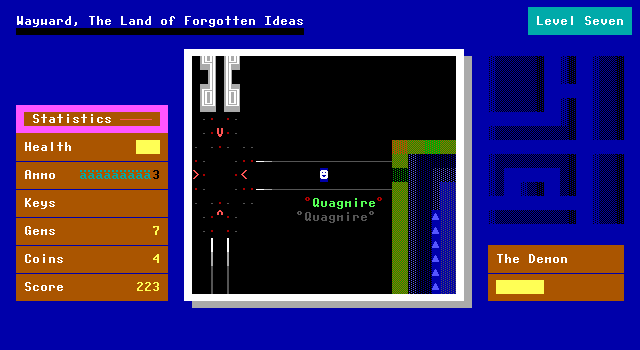
The last path of the second branch is quagmire.

Here the demon can be fought in another constrained area, but this time the walls are made out of goop. Goop is a MegaZeux element that's identical to ZZT's water, a wall that bullets can travel over but not the player or enemies.
It takes a few trips for ammo to actually get him to move once more as the demon really doesn't stick around in one place for long at all.

He eventually retreats back to the first arena, on the verge of death before being hit with that one final bullet.
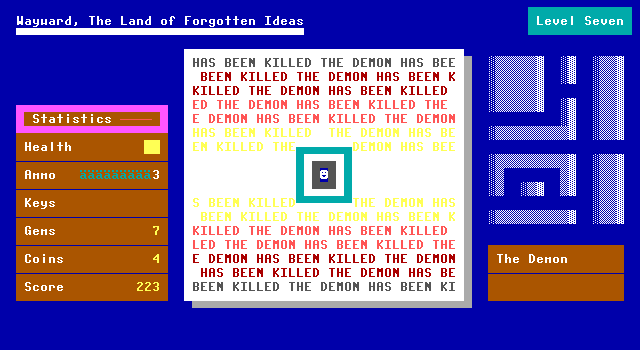
The screen flashes bright white and some creepypasta text covers the screen.
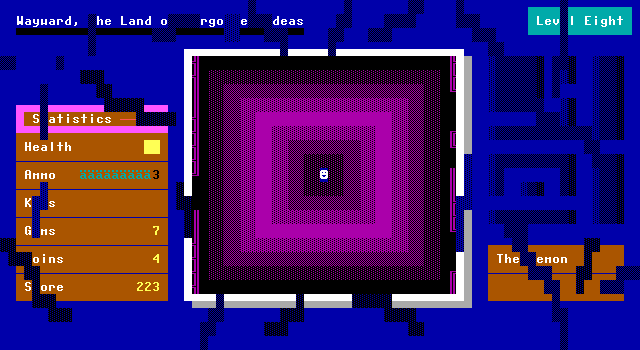
The fourth wall is shattered as Wayward can no longer function. Not only is the world broken, but the game's own HUD is damaged irreparably as the player enters level eight.

The eighth level is a purple room with damaged walls and fire. There's nothing left.
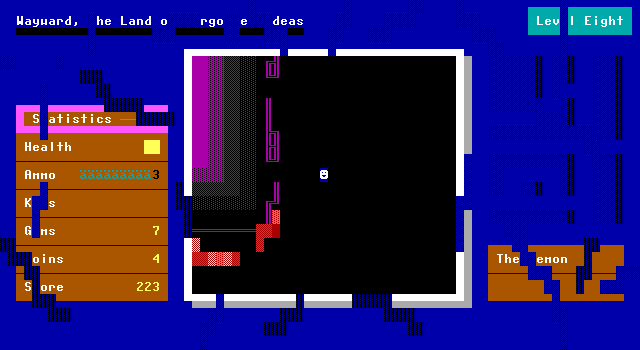
Forrester is free.
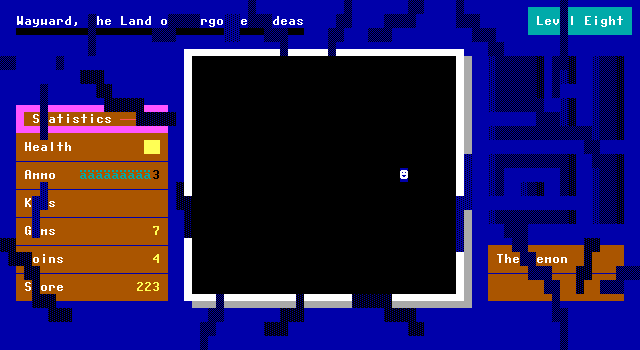
Free to wander in the darkness.
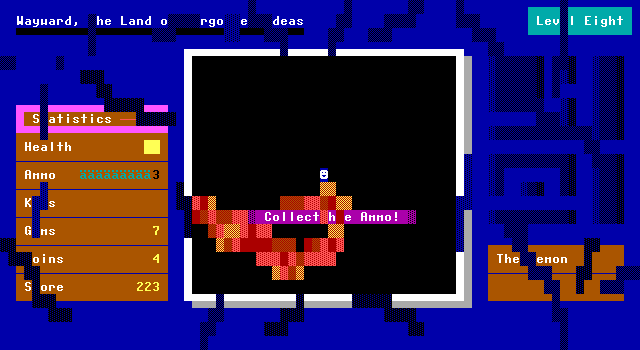
But it's not all gone. Some remnants of Wayward do remain.
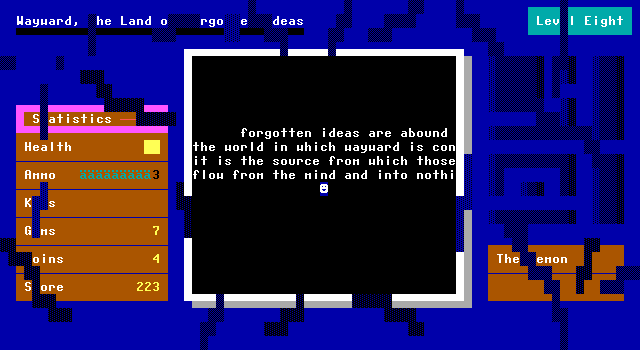
"forgotten ideas are abound
the world in which wayward is contained
it is the source from which those ideas
flow from the mind and into nothingness"
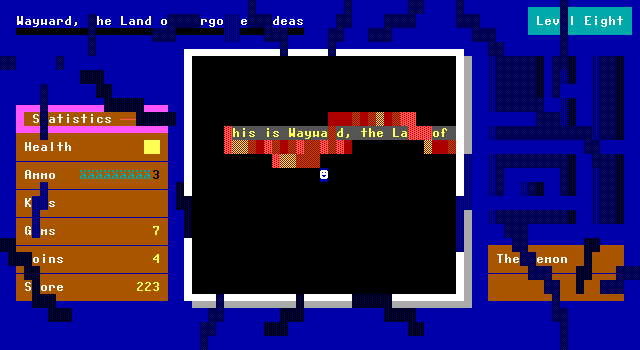
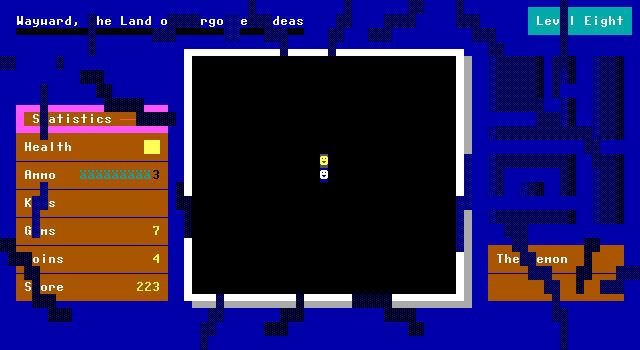
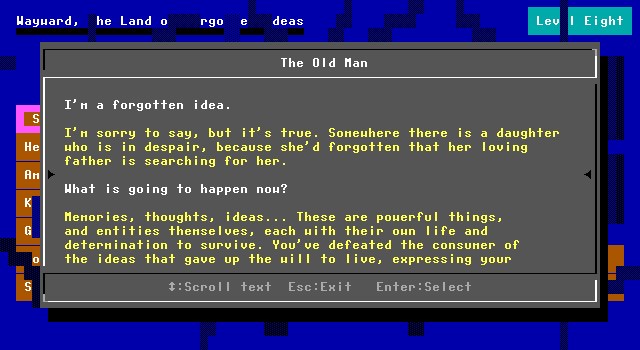
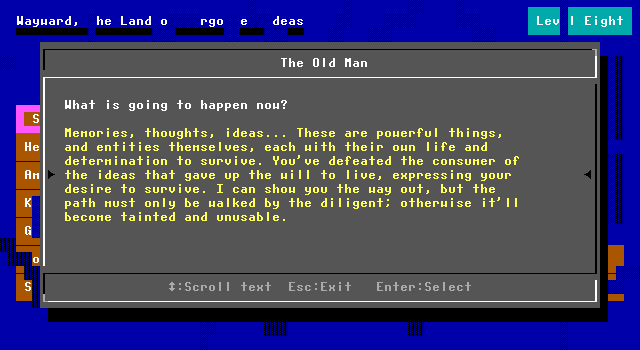
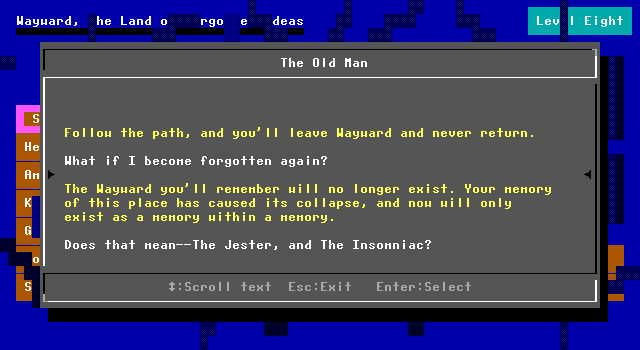
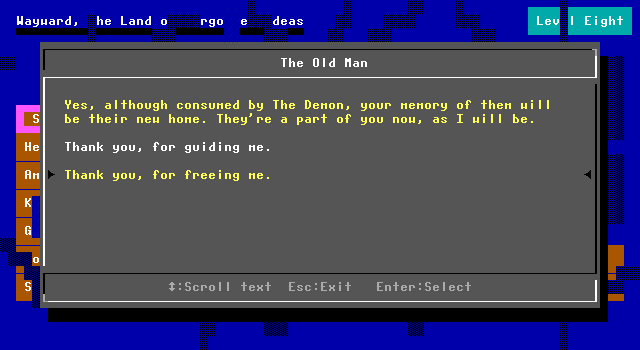

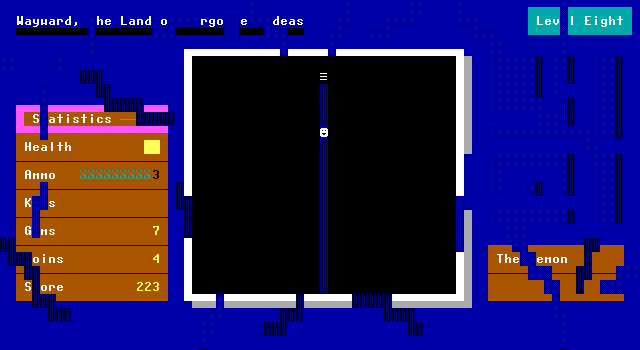
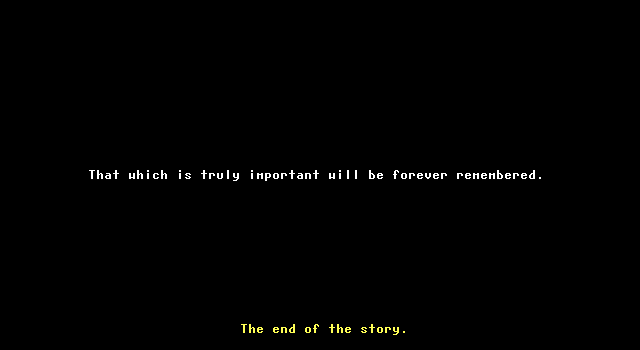
The old man is still here, and offers Forrester the way out of what was once known as Wayward. Though the Wayward as we knew it has been destroyed, it still lives on in its own way, along with the jester and the insomniac in Forrester's own memories.
Final Thoughts
Forrester is a rather unexpected combination of Super ZZT aesthetics with more serious themes expressed by its characters. Memory, the loss of it, and being lost are all some heavier topics that you wouldn't expect to see in such a colorful Monster Zoo inspired environment. I think it works out for the best that way, rather than a silly find some keys and get to the exit Super ZZT style game while a dark brooding game about being forgotten would easily fall prey to style over substance, a game to put on the shelves at Hot Topic.
By mixing the two together, Forrester becomes something unique. It's neither light-hearted nor overwrought existential angst. It's a fun journey through a more whimsical Wayward with the game's cast keeping the player from getting caught up in a fantasy world by questioning itself. Forrester had the good fortune of being released within a year of MegaZeux's port to Windows, which meant a lot of ZZTers who previously never bothered with the engine were now taking a look at what they had been missing out on. Forrester was well received within the MegaZeux community, but its aesthetics were probably more of a hit with ZZTers branching out.
The gameplay is very light, and can feel a bit like filler at times (especially when it's literally just that when playing games with the jester). Forrester was made in a time where a game without any traditional video game mechanics could face scorn as "not a game", and I have to wonder if Inmate didn't want to deal with any such accusations. If you take the ruffians and tigers out of Forrester, they wouldn't be missed, but what action is there is still basic and brief enough that while it doesn't add to the game, it doesn't detract from it either.
When you play Forrester, you're playing it for the storyline, and that's where Inmate's work with Forrester gains its substance. The characters moods swing a bit too rapidly, though they do the job of making the player think whether or not the actions they're taking in Wayward are the right ones just because they're the ones that go forward. Forrester only really scratches the surface of this compared to something like Undertale's ideas of what it means to make certain choices in games. Forrester's only choices are whether to keep going forward or to quit playing.
The game's story also suffers from being ultimately vague. There's a lot of discussion about memories being destroyed, but there's not much explanation on it. Sometimes it's very literal, with Forrester remembering he was blocked by a wall, which causes it to vanish from Wayward, but throughout the rest of the game Forrester, the jester, the old man, and the insomniac all converse and remember each other without issue. The insomniac's level is destroyed, but the UFO is revisited. I suppose it's a distinction of remembering things and experiencing them. The later levels when Wayward begins to crack also bring up unanswered questions about the significance of the calendar or the highway and Forrester looking traveller. It's hard to tell what's in Forrester to create a cohesive journey and what's there to make sure there's something there at all. I can read the traveller as Forrester being forgotten by his friends, and the game certainly doesn't have to explicitly explain itself, but despite the tone shift in the latter half of the game, there's no real indication that there was a _why_ for the tone shift.
It could all be a load of bunk. It could be a thoughtful piece about being forgotten. It could be Super ZZT. It could be MegaZeux. I'm not sure what Forrester is, but it's something that stands out as a bridge between two related budding game developer communities. If you're looking for a good stepping stone into MegaZeux and have experience with ZZT, don't forget about Forrester.
https://patreon.com/worldsofzzt" target="_blank">Support Worlds of ZZT on Patreon!
